“Talent has no borders, and technology connects the world in ways we couldn’t have imagined a decade ago,” – Satya Nadella, CEO of Microsoft.
By bringing together skilled professionals from across the globe, each with unique strengths, insights, and expertise, this business strategy creates an environment where creativity, efficiency, and strategic problem-solving flourish. This blog explores why Offshore Software Development (OSD) is the best solution for businesses to drive growth and unlock potential opportunities. And maybe, you could be one of them after reading this blog.
In case you don’t have time to read full article, we have provided the Summary part at the end of the blog – which demonstrates the main important information so you can understand about Offshore Software Development.
1. Introduction to Offshore Software Development (OSD)
Initially, we will discuss the role of OSD, charting its history and significance, and providing actionable insights for businesses considering offshore software development as part of their growth strategy
a. What is Offshore Software Development?
Offshore Software Development is a business strategy where a company outsources its software development processes to a team, or an entire center located in a foreign country.
Simply, it is a combination of cost-effectiveness yet high technical expertise, and specialized skills, which may not be found locally. Offshore software development can involve tasks ranging from coding and design to testing, deployment, and ongoing support, making it a very comprehensive solution for companies looking to scale their software operations efficiently.
For example, imagine a U.S.-based company that needs a mobile app developed. Instead of hiring local developers, which could be costly and time-intensive, the company decides to work with an offshore development team in India.
This offshore team handles everything from coding to testing the app. As a result, the company receives a high-quality mobile app at a fraction of the cost of local development.
b. History and evolution
Offshore software development was born out of the need for businesses to address two primary challenges: cost reduction and access to skilled talent.
During the 1980s and 1990s, as technology became integral to operations, companies, particularly in high-cost regions like North America and Western Europe, began seeking ways to manage escalating labor costs without compromising quality. With the rise of the internet and digital communication tools in the early 2000s, OSD transformed from a cost-cutting initiative into a strategic advantage, enabling real-time global collaboration.
By the 2010s, Eastern Europe, Latin America, and Southeast Asia also became popular offshore destinations, expanding the talent pool and fostering specialized development hubs
Nowadays, thanks to globalization and advances in digital communication, it is possible for us to manage projects seamlessly across borders, and leverage time zone differences in offshore strategies.
c. OSD’s importance in the global technology industry
Subsequently, OSD has solidified its position as a foundational element in the global tech industry, reshaping how companies approach development, innovation, and operational strategy.
By establishing hubs in strategic offshore locations, OSD has helped transform developing regions into global tech powerhouses, each specializing in high-demand areas. This shift has cultivated a truly global workforce, where expertise flows across borders.
Moreover, it has fueled growth for tech startups and enabled large corporations to adapt quickly in a fast-paced environment. So, OSD has supported the rise of technology-led economies, driving economic growth and innovation in offshore regions
d. Who should use OSD?
With distinct needs and wants, the strategy can be and should be applied beyond individual startups to large enterprises. Nevertheless, below, we suggest some of those who might grow powerful if use the right OSD strategy:
- Startups and SMEs: These businesses often face a challenge with limited budgets and small teams. By outsourcing development offshore, they can access top-tier talent without the high costs of in-house hiring but still able to compete.
- Needs for scalability: Mid-sized tech companies that have outgrown their current development capacities can use OSD to scale operations without committing to the long-term expenses of local hires.
- Need for specialized skills: Large corporations often require specialized expertise in different fields which may be limited locally or prohibitively expensive. By tapping into global markets, they can source these niche skills at a reasonable cost.
- Need for time optimization: Companies aiming to shorten time-to-market for their products – especially in fast-evolving industries like finance, e-commerce, and healthcare—can leverage OSD to ensure continuous productivity across time zones.
- Need for a shift in digital transformation: Traditional businesses have no choice but to adopt transformation initiatives since they must stay competitive and integrate modern solutions into their core operations like everyone is doing.
Additionally, even well-established companies in developed markets should consider OSD as a strategic option. OSD is no longer just a solution for startups and growing companies because it’s a critical tool for even the most mature businesses aiming to stay agile and forward-thinking in today’s global tech landscape.
e. Is OSD right for you?
By answering questions about cost priorities, skill needs, resource scalability, and time-to-market, you can better assess whether OSD aligns with your strategic goals.
If you identify a strong need for cost efficiency, specialized skills, and flexibility, OSD could be an advantageous choice. Alternatively, if these needs are less critical, in-house or local development may be a more suitable option.
For more insights into achieving success in outsourcing, particularly in a digital age, consider McKinsey’s perspective on business process outsourcing, which highlights strategies to adapt outsourcing efforts for maximum effectiveness in today’s tech-driven environment.
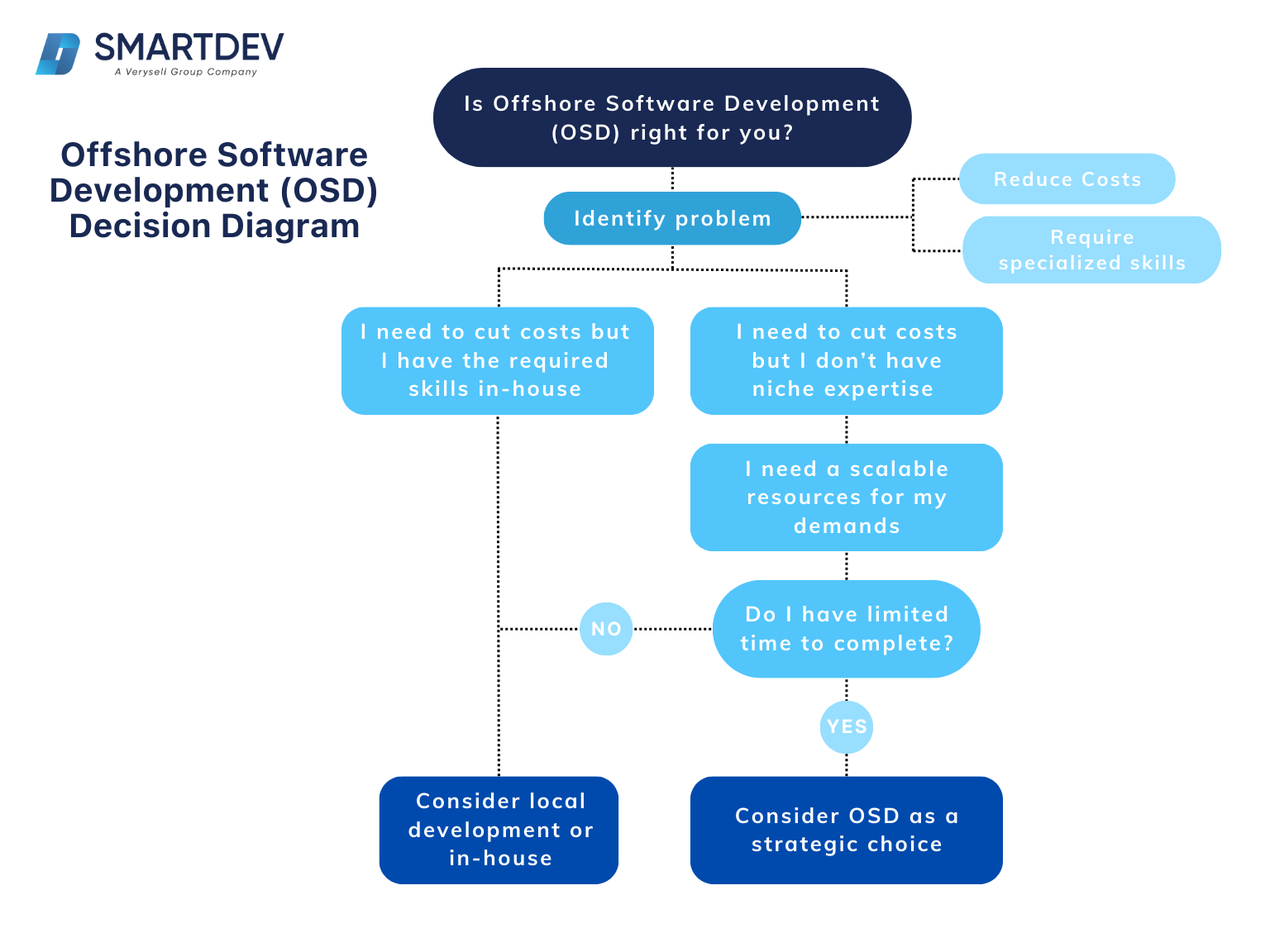
2. Types of Outsourcing in Software Development
In the tech world today, many places have been applying various types of outsourcing depending on the clients’ markets or the characteristics of each industry.
Most IoT firms can bring flexibility in offering different options that fit for businesses below.
a. Offshore vs Nearshore vs Onshore
There are three main types of software outsourcing models, each suited to different business needs and proximity preferences:
- Onshore Outsourcing: This model involves outsourcing to a service provider within the same country. It allows for seamless communication and similar cultural practices but often comes at a higher cost.
- Nearshore Outsourcing: In this model, companies outsource to nearby countries, usually within the same region or time zone, making collaboration convenient while offering moderate cost benefits.
- Offshore Outsourcing: This is contracting work to distant countries, often providing substantial cost savings and access to a broader talent pool due to global reach.
b. Hybrid Models (Waterfall & Agile) and When to Use Each
In software development, there are two distinct approaches: the Waterfall Model and Agile Model. But, in modern days, a blend of those two traditional and agile methods – the Hybrid Model allows teams to flexibly use Agile’s iterative approach for certain parts of a project while employing Waterfall’s structured methodology for others.
Waterfall Model: Use a linear, sequential model where each phase – requirements, design, implementation, testing, and maintenance – is completed before moving to the next. It’s best for projects with clear, fixed requirements and minimal need for change, like regulatory or large-scale enterprise systems.
Key features:
- Requirements are set at the beginning and do not change.
- Each phase has a specific sequence, making project planning and tracking straightforward.
- With well-defined requirements and schedules, it’s easy to plan timelines and costs.
- Extensive documentation supports maintenance and new developer onboarding.
Agile Model: Is an iterative, flexible approach where work is divided into small, incremental sprints, focusing on customer feedback and adaptation. Agile is ideal for dynamic projects, such as software or web applications, where requirements may evolve.
Key features:
- Regular feedback from stakeholders guides each sprint.
- Requirements can adapt based on user feedback.
- Emphasizes teamwork and collaboration.
- Incremental releases enable faster time-to-market.
Hybrid Model: Combines Waterfall’s structured phases with Agile’s adaptability, often using Waterfall for high-level planning and Agile for development and testing. This approach provides flexibility in areas where change is frequent and unpredictable, making it ideal for complex projects that require a combination of methods.
Key features:
- High-level stages with adaptive sub-phases.
- Suitable for complex projects needing phases with both fixed and flexible elements.
- Early planning mitigates risk while Agile aspects support changes.
- Suitable for projects needing stability and flexibility.
Which One Should You Choose?
Choose Waterfall Model if the projects are stable, have clear requirements and defined end goals (e.g., government or compliance projects).
Choose Agile Model if the projects include evolving requirements or in need of rapid releases and customer feedback (e.g., mobile apps).
Choose Hybrid Model if you are managing large and complex projects that benefit from both structured planning and flexibility (e.g., ERP systems).
c. Key Differences: Benefits and Challenges
Each type offers unique benefits, with trade-offs in proximity, collaboration ease, and access to specialized skills, enabling companies to choose the best fit for their strategic goals.
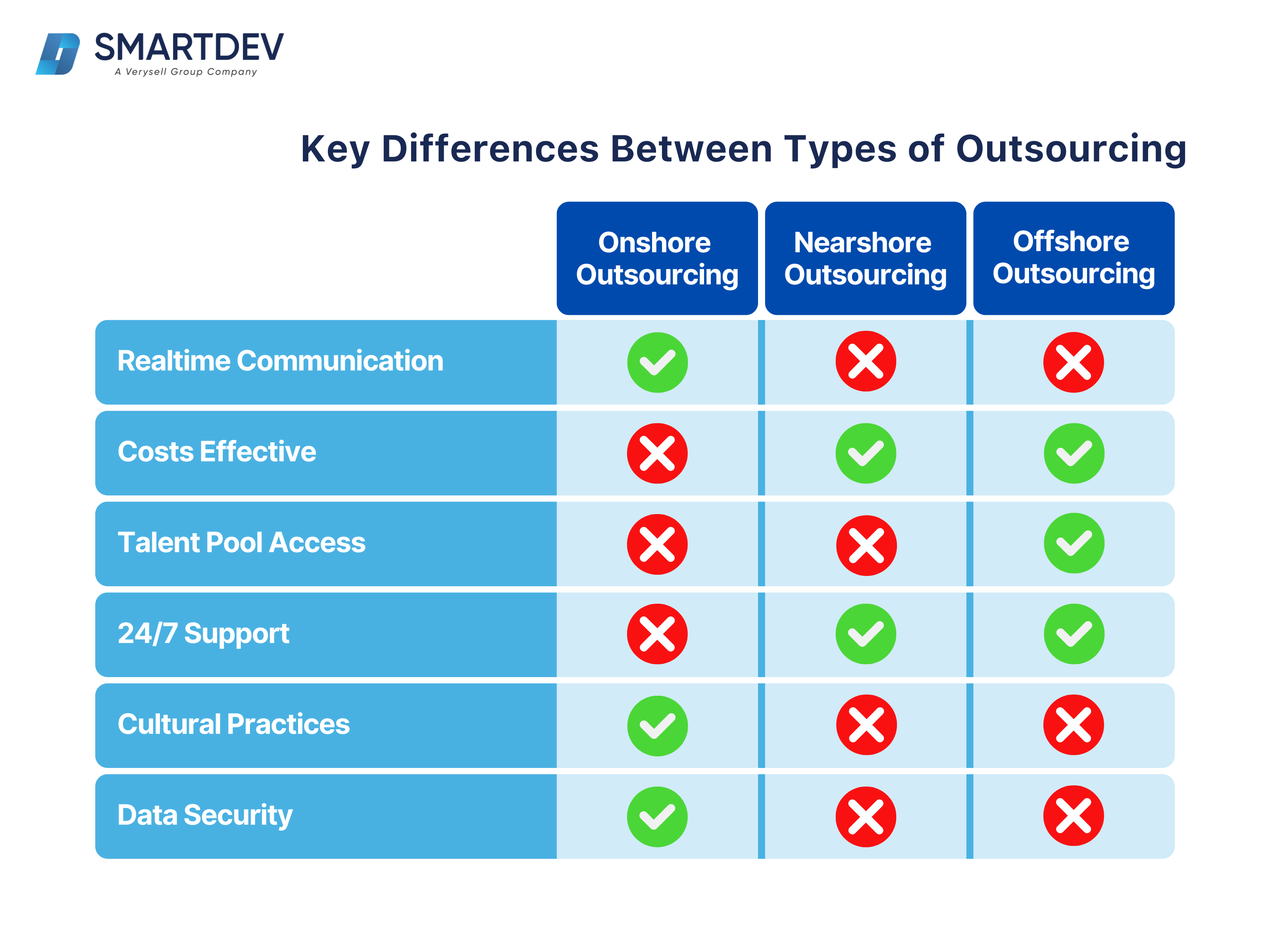
d. What Types of Services Can Be Outsourced
In Information Technology Outsourcing (ITO), a wide range of services can be outsourced, depending on the company’s needs and objectives. These include:
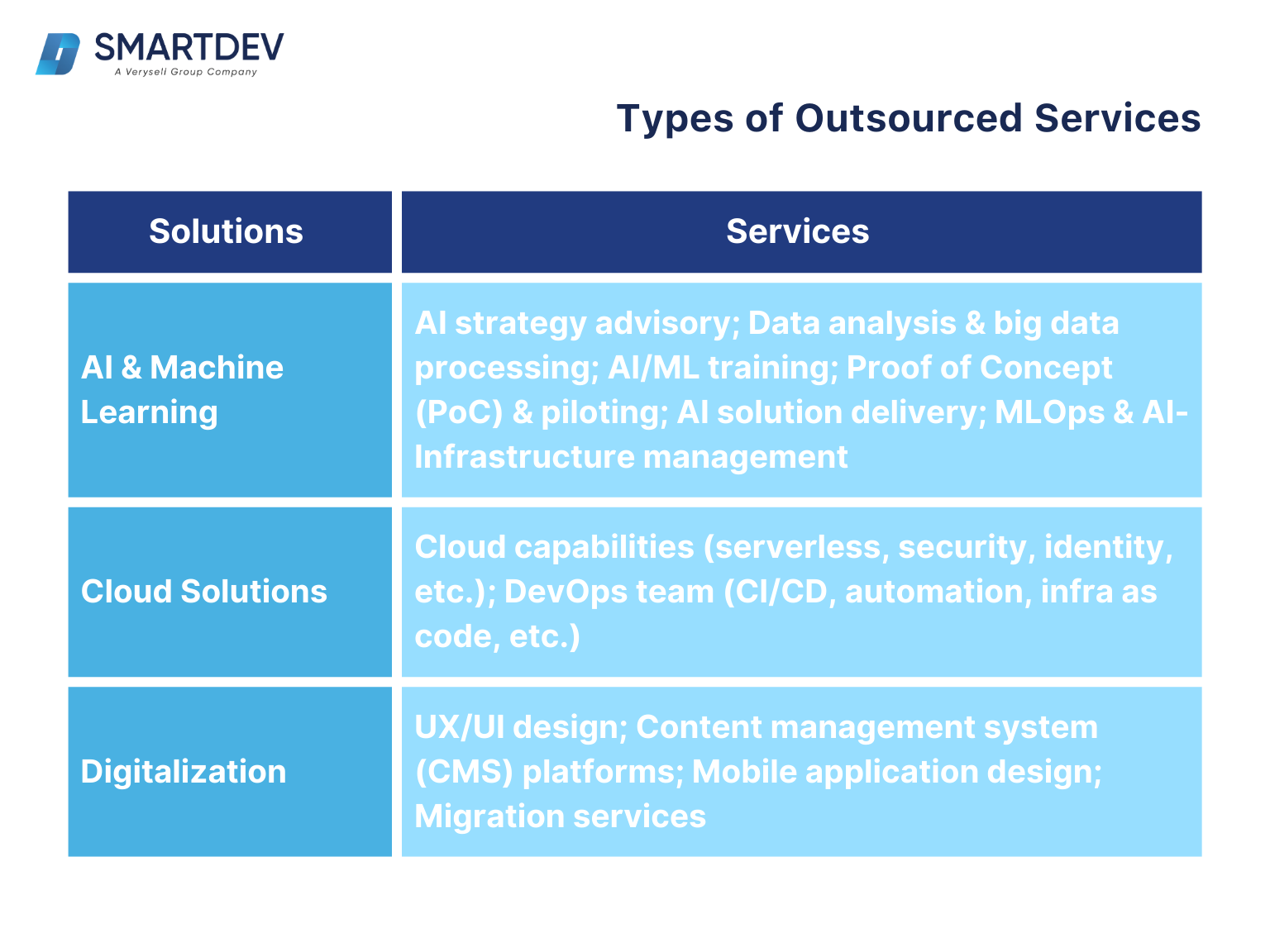
3. Cost of Offshore Software Development
When considering offshore software development, understanding the cost structure is essential for making informed business decisions.
This analysis highlights the key cost components, including developer salaries, management fees, and technology stack expenses, while comparing rates across different regions.
By recognizing the various factors that influence costs, businesses can effectively strategize their budgeting and maximize their return on investment.
a. Cost Breakdown
Offshore Software Development offers a cost-effective solution for businesses but involves several key cost components.
The main cost drivers are developer salaries, which typically account for the majority of expenses. In addition to this, there are management fees for team supervision and project coordination, and technology stack costs, which vary based on the platforms, tools, and infrastructure required for development.
The technology stack can range from using cloud platforms like AWS or Azure, to specific software solutions such as Shopify or Magento, each adding its own cost layer depending on licensing, integration, and scalability needs.
b. Cost Comparison
Offshore development rates vary significantly by region, with developer salaries in different parts of the world being one of the biggest factors driving this variation.
- Eastern Europe: Countries like Ukraine, Poland, and Romania offer skilled developers at competitive rates of $30 to $50 per hour. This region is known for its strong educational systems and high technical proficiency.
- South Asia: India, Pakistan, and the Philippines are among the most cost-effective regions, with rates ranging from $20 to $40 per hour. South Asia is a global outsourcing hub, particularly for IT and software development.
- Latin America: With countries like Brazil, Argentina, and Mexico, rates range from $30 to $60 per hour. Proximity to the U.S. and fewer time zone differences make this region attractive for North American companies.
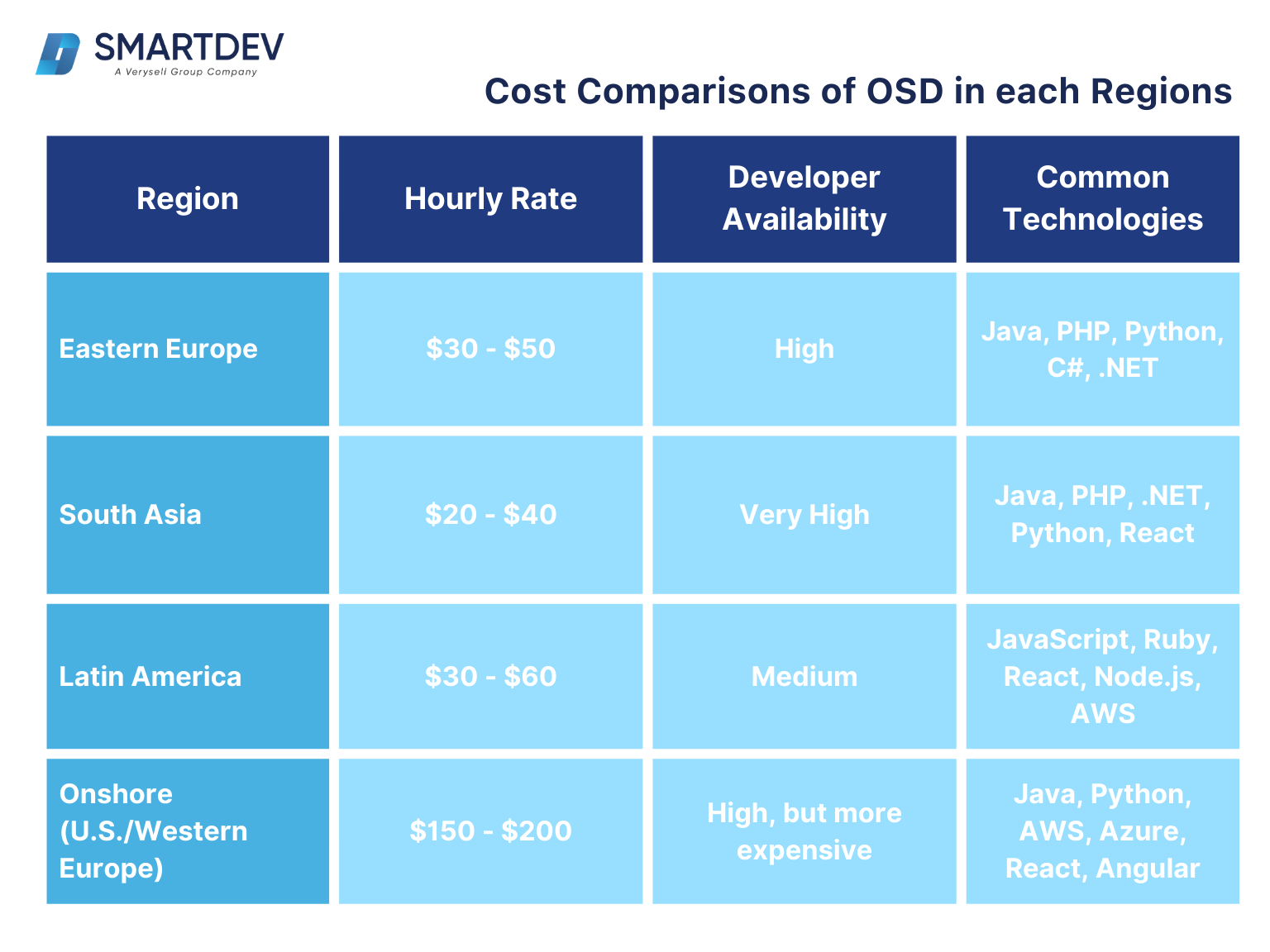
These regional variations offer businesses flexibility in choosing offshore teams based on their budget and project needs.
c. Factors Influencing Cost
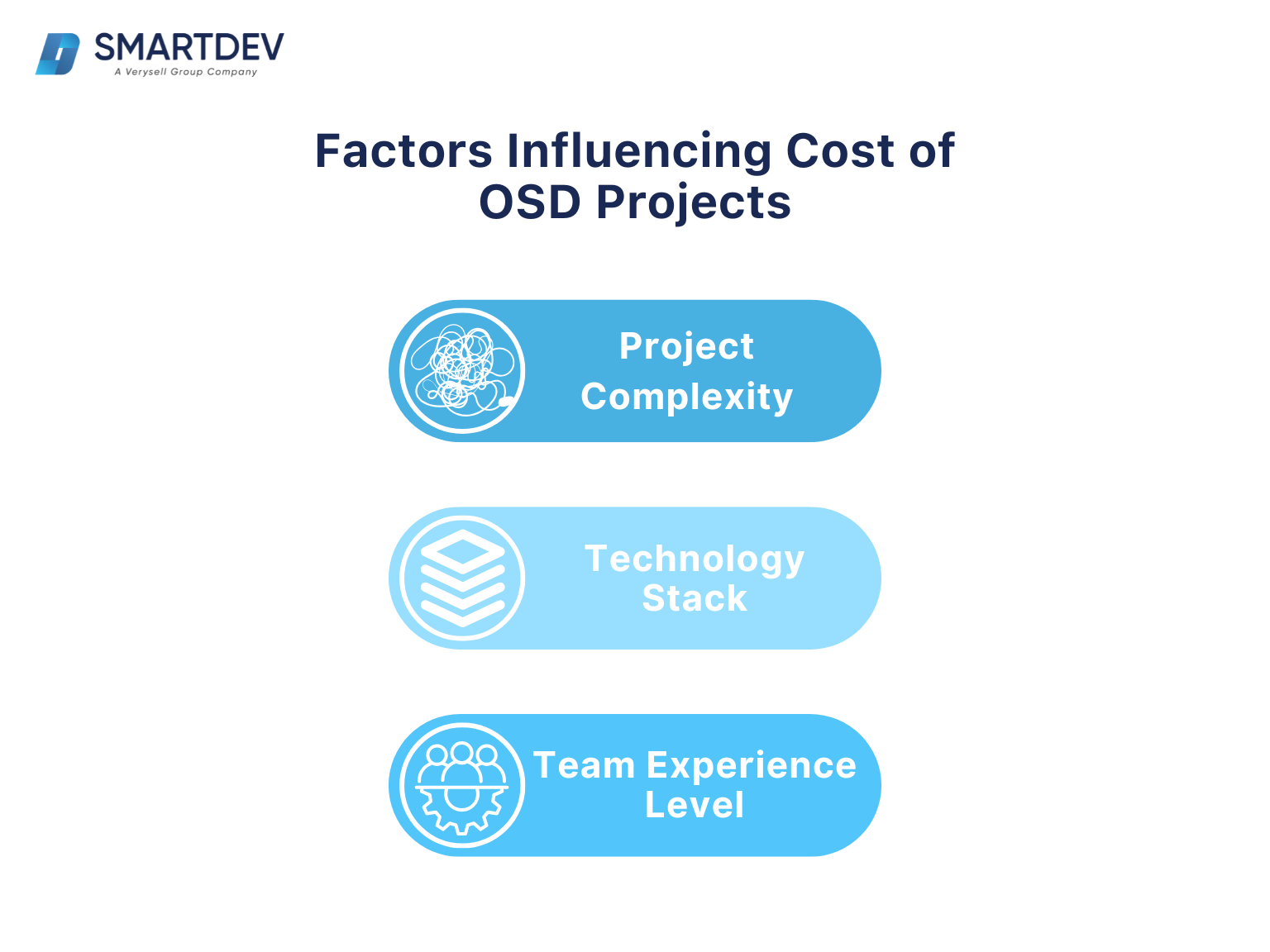
Several variables affect the cost of offshore software development beyond just the hourly rates.
- Project Complexity: More complex projects require specialized skills and technologies, driving up costs. For example, projects involving artificial intelligence, blockchain, or custom algorithms can significantly increase development expenses.
- Technology Stack: The choice of technology stack influences cost. Using advanced platforms like AWS, Azure, or Magento may add licensing, hosting, and integration expenses compared to open-source technologies like PHP or Python.
- Team Experience Level: More experienced developers, particularly those with niche expertise, charge higher rates. For example, senior developers with experience in cloud computing or cybersecurity may command hourly rates up to 50% higher than general developers.
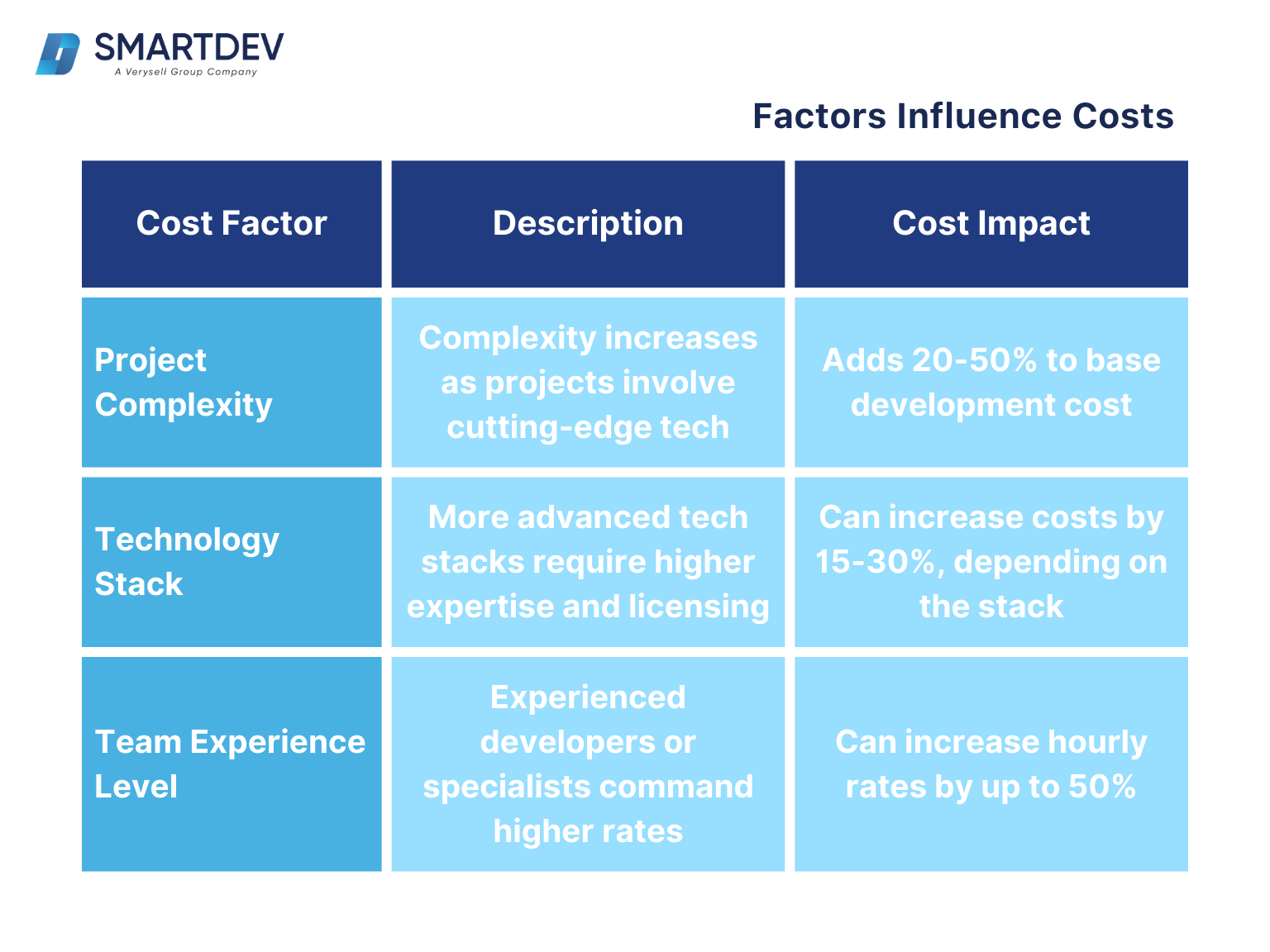
These factors can make a significant difference in the total cost of offshore development projects.
d. Hidden Costs to Watch For
While Offshore Software Development promises lower hourly rates, hidden costs often emerge. Some factors include:
- Communication Challenges: Language barriers or cultural differences can cause misunderstandings, leading to delays or rework. Studies show that 55% of companies experience communication issues when working with offshore teams.
- Time Zone Differences: Offshore teams in different time zones can slow down decision-making and collaboration, particularly in agile environments. The average delay in feedback and decision-making due to time zone gaps can add 15-20% more time to project timelines.
- Additional Project Management: Companies may need to invest in extra project management resources to oversee offshore teams and ensure continuous communication. This could result in a 10-15% increase in project costs.
- Quality and Rework: Poor code quality or a lack of experience can lead to higher technical debt, requiring additional budget to refactor or fix issues. 25% of offshore projects report needing significant rework due to inadequate initial outputs.
Here’s a table outlining the potential impact of hidden costs:
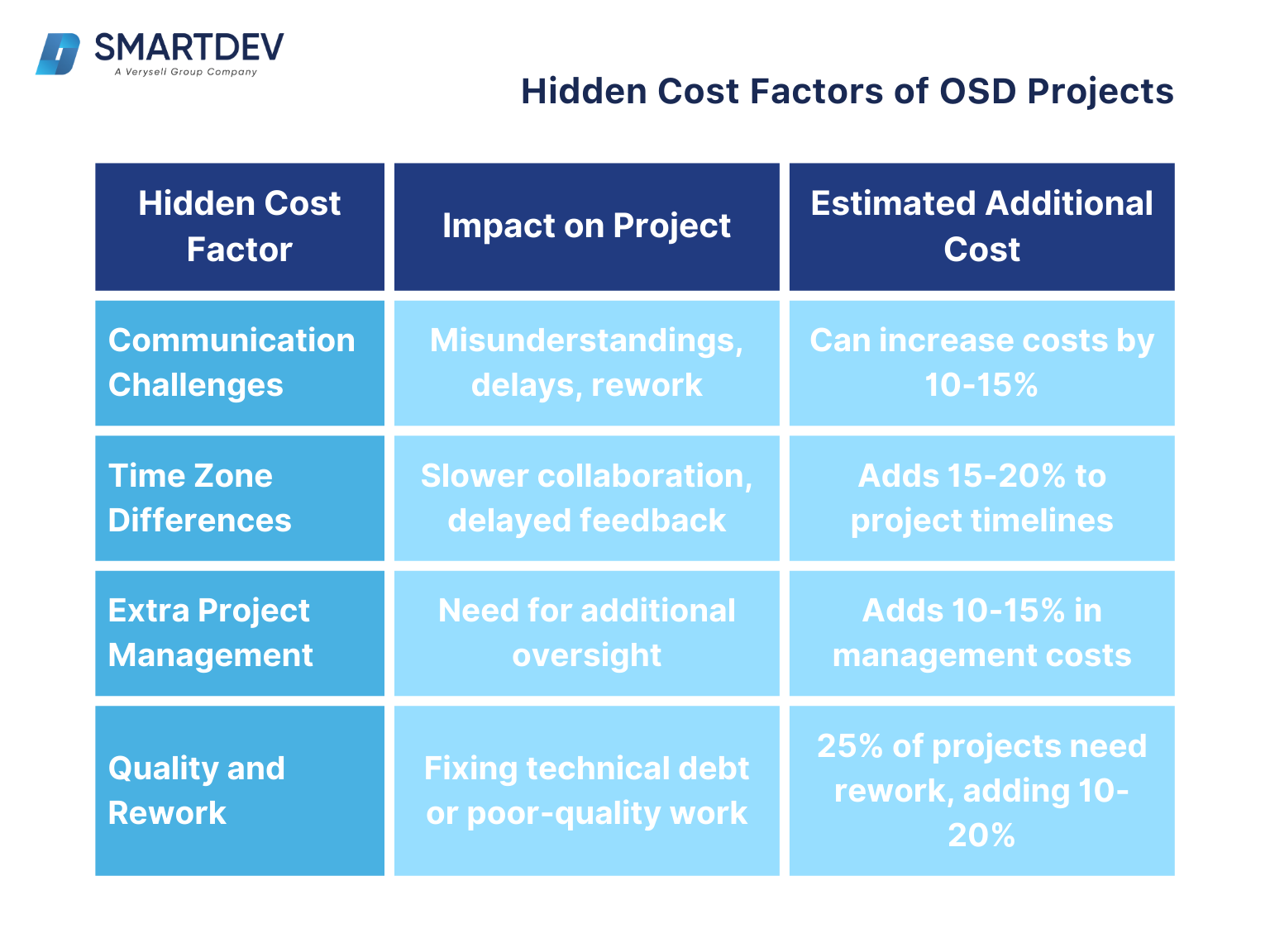
e. Offshore vs Onshore Cost Savings
Despite these potential hidden costs, businesses can realize substantial savings by choosing offshore over onshore development.
For example, U.S.-based companies may pay $150 to $200 per hour for an in-house or onshore development team, while an offshore team in Eastern Europe or South Asia can cost only a fraction of that—around $30 to $50 per hour.
Over the course of a year, this could result in savings of up to 60% or more. A company needing 1,000 hours of development might spend $150,000 in the U.S., whereas an offshore team could deliver the same work for $50,000 to $70,000.
Here’s a breakdown of the cost comparison:

Choosing Offshore Software Development can reduce costs by 50% to 70%, which makes this model particularly attractive for startups, SMBs, and enterprises looking to optimize their IT budgets without sacrificing project quality. A recent Harvard Business Review article outlines some essential principles for successful offshoring, focusing on how to balance cost, risk, and quality—principles we embrace and adapt within our own operations.
4. Key Benefits of Offshore Software Development
Offshore Software Development (OSD) has become a key strategy for companies looking to innovate, optimize costs, and boost growth. Therefore, if you are looking for one of the key benefits of OSD below as a solution for your business then what’s stopping you from achieving it?
- Cost Saving: By outsourcing to regions with lower labor costs, OSD helps reduce recruitment, training, and operational expenses, freeing up funds for strategic investments.
- Global Talent Access: OSD provides access to highly skilled specialists worldwide, enhancing innovation and broadening expertise beyond local markets.
- Fast Time-to-Market: Operating in different time zones enables 24/7 development, allowing quicker project completion and product launches.
- Core Functions Focusing: With technical tasks managed offshore, in-house teams can focus on strategy, customer experience, and growth, driving overall productivity.
- Scalability and Flexibility: OSD lets companies scale resources based on project demands, making it easy to expand or downsize as needed without the commitment of permanent hires.
- Quality Improvement: OSD gives you an expert team overseeing your project, enhancing overall product quality through effective assessment and reporting methods.
This strategy not only provides the above gains but also builds a strong and firm foundation for every business to drive long-term development and ensure smooth operation in any industry.
For deeper insights into how offshore development strategies can impact your business success, check out this detailed report from Gartner, a trusted resource for industry research and analysis.
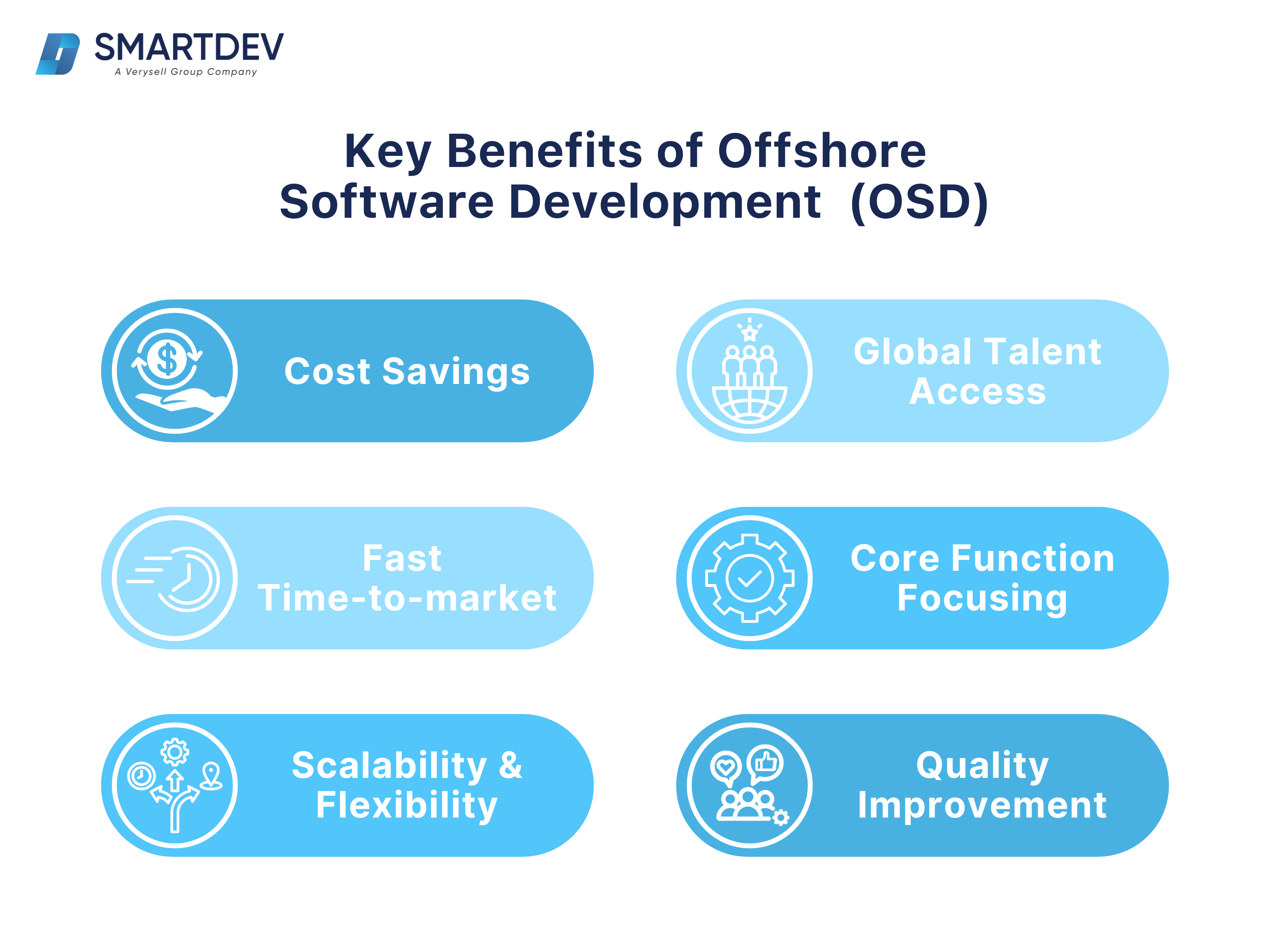
5. Common Challenges in Offshore Software Development
Offshore software development (OSD) presents distinct challenges, primarily involving time zone differences, communication barriers, and varying quality standards across regions.
Both clients and vendors must navigate these obstacles through proactive communication, quality control, and cybersecurity measures to protect sensitive data, while in-house teams often face difficulties in seamlessly integrating offshore work.
a. For Clients
Firstly, with team members often spread across multiple time zones, OSD can make real-time communication difficult, increasing the likelihood of miscommunications. Language differences and cultural variations can also affect how information is interpreted.
Furthermore, while OSD offers access to highly skilled talent, quality standards can vary between regions. Clients often have to implement additional quality controls and may require more frequent check-ins, which may affect the timeliness of the project as well.
Besides, security regulations differ globally, which can pose risks to sensitive data. OSD requires robust cybersecurity policies and may involve navigating regional privacy laws, adding to the client’s compliance burden.
We suggest that implementing a clear communication protocol or assign local project managers to bridge the gaps, quality benchmarks to align the expectation, and sign non-disclosure agreements (NDAs) as well as encrypted data handling practices to secure information.
b. For Offshore Vendors
Initially, offshore vendors face quite challenges of understanding and meeting client expectations from afar, particularly when project details are complex or iterative.
This often necessitates a highly adaptive approach to communication and project management, with vendors required to be proactive in seeking clarifications and updating clients.
There are also barriers in resource management and time zone differences. Offshore vendors must manage teams across varying time zones, balancing productivity while respecting work-life boundaries of employees. Collaborative tasks can sometimes mean irregular work hours, impacting productivity and team morale over time.
But there is always room for improvement. These challenges can be mitigated by methods such as offering a cross-cultural session or an onboard training course early on to learn clients’ preferred methodologies and tools.
Regarding time zones issue, we can foster a positive work environment by benefits such as hybrid working to give employees the autonomy choosing where and when to work.
c. For In-house Teams
While OSD can offload certain tasks, in-house teams often find it challenging to integrate offshore work with internal processes.
For instance, an in-house team may have developed the core product architecture, but a specific feature development is outsourced offshore. If there’s a lack of consistent communication or delays in updates, the in-house team may have to wait for the offshore team to complete their tasks.
In addition, managing tasks between onshore and offshore teams requires clear allocation of responsibilities, with in-house teams often needing to provide guidance or conduct knowledge transfers. Without effective resource planning, overlap in tasks or gaps in responsibility can emerge, reducing overall efficiency.
Addressing these issues, using robust project management software to track task progress, assign responsibilities clearly, and regularly review will surely help everyone meet deadlines and align the goals.
Understanding when to engage offshore developers can make or break the success of your project. The decision often depends on factors like project scope, budget, and the need for specialized skills that may not be readily available locally. For those weighing the pros and cons, this article by Forbes Tech Council offers valuable insights on identifying the right moment to opt for offshore development.
6. How to choose an Offshore Software Development
Choosing the right offshore software development vendor requires a careful evaluation process to ensure the vendor can meet your project needs, align with your goals, and adhere to legal standards.
The following criteria will be the key considerations when selecting Offshore Software Development Partners.
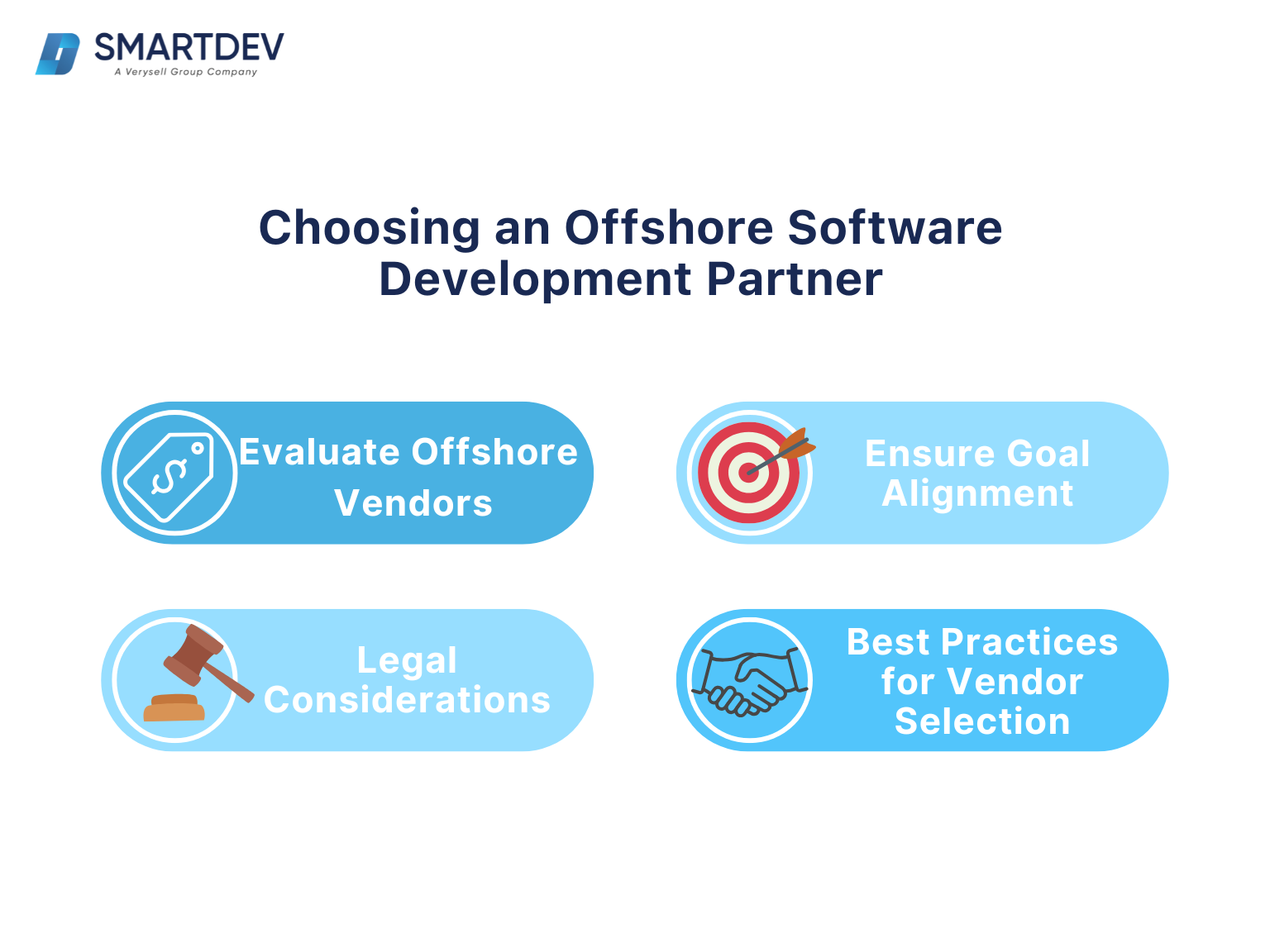
a. Criteria for Evaluating Offshore Vendors
When evaluating offshore vendors, companies should focus on several important criteria:
- Technical Expertise: Assess the vendor’s proficiency in the required technologies. This includes checking their experience with the relevant tech stack (e.g., AWS, Magento, Shopify).
- Portfolio & Case Studies: Review previous projects to gauge the vendor’s experience in similar projects and industries.
- Communication & Cultural Fit: Good communication practices and cultural alignment are critical to avoiding misunderstandings and delays. Ensure the vendor has established communication processes.
- Cost vs. Quality: While lower rates are attractive, evaluate whether the vendor’s pricing aligns with the quality of work you require.
- Scalability & Flexibility: Ensure the vendor has the capacity to scale the team or project size as needed and can adapt to changing project requirements.
b. How to Ensure Alignment of Goals and Expectations
Ensuring alignment of goals and expectations with an offshore vendor is crucial for project success. This can be achieved through the following:
- Clear Requirements: Provide the vendor with well-documented project requirements and specifications. This reduces the chances of miscommunication and ensures the vendor understands your needs.
- Regular Communication: Establish regular check-ins and updates to keep the project on track. Weekly or bi-weekly meetings help align goals and address potential issues early.
- KPIs and Metrics: Define clear performance metrics (KPIs) to measure the success of the project and monitor vendor performance. Examples include project deadlines, quality benchmarks, and bug-free delivery.
- Feedback Loop: Create a feedback process where both parties can openly discuss progress, challenges, and potential improvements.
c. Legal Considerations
Legal protection is a critical aspect of working with offshore vendors. Here are key legal considerations:
- Contracts: A clear, detailed contract is essential. It should outline the scope of work, timelines, payment terms, and dispute resolution procedures.
- Intellectual Property (IP) Protection: Ensure the contract covers IP ownership rights, especially for custom software development. Define who owns the code, software, and any new technologies created during the project.
- Data Security: Ensure the vendor complies with local and international data protection regulations, such as GDPR, if applicable.
- Dispute Resolution: Include a dispute resolution clause that specifies how conflicts will be managed, whether through arbitration or other legal methods.
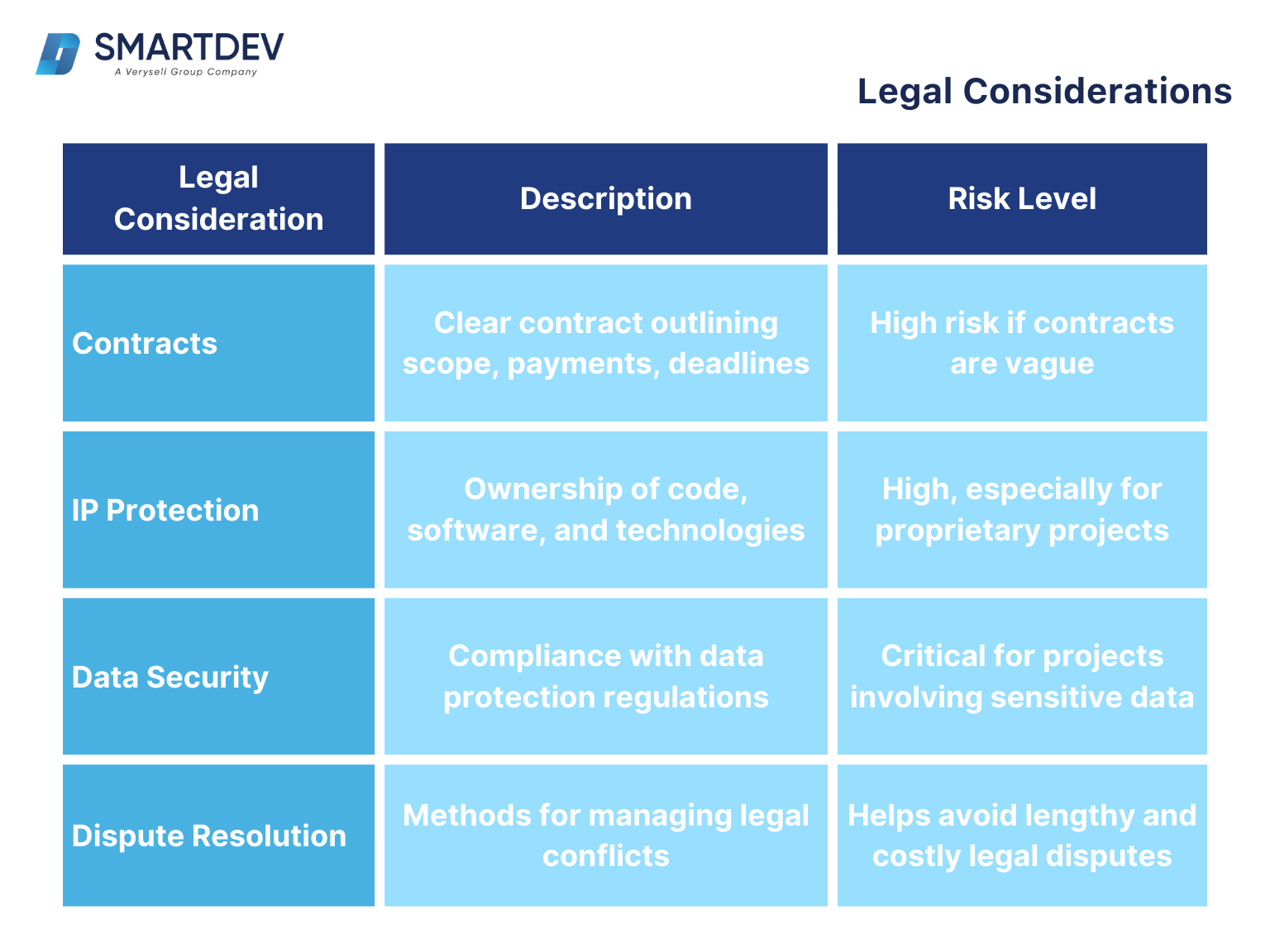
d. Best Practices for Vendor Selection
To maximize the chances of a successful offshore development partnership, it’s important to follow established best practices that help you thoroughly vet and evaluate potential vendors. These processes including:
- Pilot Project: Start with a small pilot project to evaluate the vendor’s capabilities before committing to a larger engagement.
- Reference Checks: Contact the vendor’s previous clients to understand their working experience, reliability, and quality of work.
- Vendor Interviews: Conduct interviews with key team members to assess their technical skills, communication abilities, and cultural fit.
- Site Visits (if possible): If feasible, visit the vendor’s location to assess their infrastructure, team dynamics, and work environment.
- Third-Party Reviews: Use platforms like Clutch or G2 to review the vendor’s reputation and read feedback from past clients.
7. Offshore Development Team Structure
Offshore development team structures vary to suit project needs, with dedicated teams providing long-term support for evolving projects and project-based teams focusing on specific, one-time assignments. Each team includes essential roles like project managers, developers, and quality assurance engineers, ensuring efficient project management, technical guidance, and high-quality delivery.
a. Team Models: Dedicated Teams vs Project-based Teams
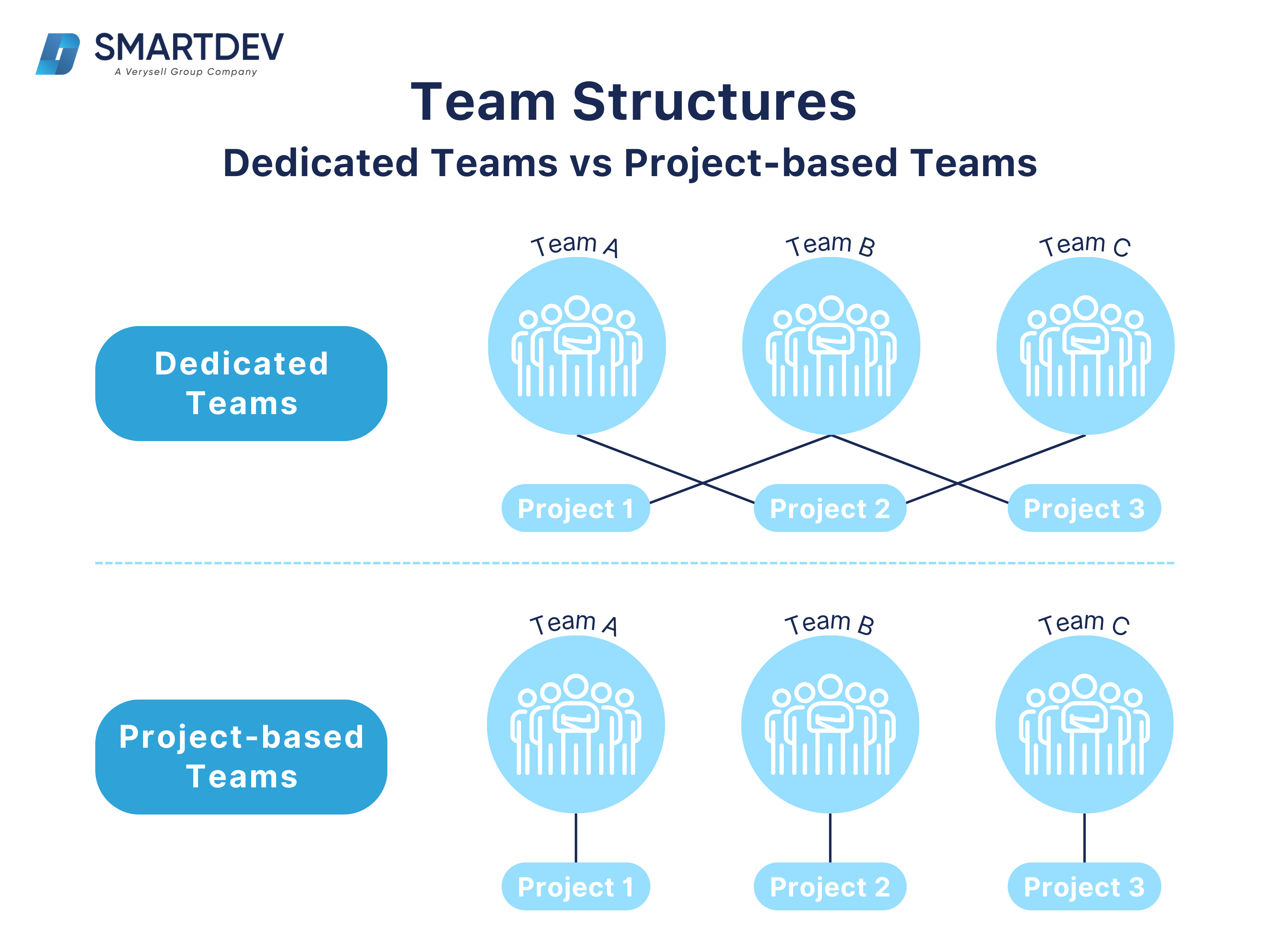
Dedicated Development Team: This model involves forming a long-term team dedicated exclusively to the client’s projects, acting as an extension of the in-house team. They handle ongoing tasks, align with company processes, and provide consistent, integrated support. Ideal for companies with evolving, complex projects needing flexibility and specialized skills over time.
Project-based Team: The team is assembled specifically for a single project with a clearly defined scope, objectives, and timeline. Unlike a dedicated team, this team’s focus is solely on completing one project, from start to finish, rather than ongoing or evolving work. Once the project is delivered, the team disbands or moves to other assignments. This structure is ideal for projects with fixed requirements and a set deadline, such as developing a single app, feature, or a website.
b. Role Distribution
In an OSD team, roles are typically structured to cover both technical and project management needs, ensuring efficient collaboration and delivery:
- Project Manager (PM): Manages planning, timelines, and communication between the client and the team, ensuring alignment with project goals.
- Team Lead or Technical Lead: Provides technical guidance, oversees code quality, and supports developers in solving technical challenges.
- Developers: Write and implement code, working on the software’s functionality according to project requirements.
- Quality Assurance (QA) Engineers: Test the software for bugs, functionality, and performance, ensuring high standards.
- UI/UX Designers: Focus on the software’s user experience and interface design, creating intuitive and user-friendly layouts.
- DevOps Engineers: Manage deployment, automation, and infrastructure, supporting a smooth production environment.
- Business Analysts (BA): Conduct market analysis, identify potential risks, and ensure that the final product will meet the intended business objectives.
Each role plays a part in delivering a high-quality, efficient product by maintaining communication, technical integrity, and user-focused design.
8. Technology Stack Selection in Offshore Development
When embarking on an offshore development project, selecting the right technology stack is critical to the project’s success. The tech stack consists of the various tools, frameworks, programming languages, and platforms that will be used throughout the development process. Making the right choice can significantly impact the quality, scalability, and performance of the final product, as well as the ease of collaboration with the offshore team.

a. Popular Technologies for Offshore Development Projects
Offshore development often involves the following popular technology stacks:
Frontend Technologies:
- React.js: Known for building interactive UIs, React is widely used in offshore development for web applications.
- Angular: A full-fledged front-end framework, especially suited for building complex enterprise applications.
- Vue.js: A lightweight JavaScript framework, Vue is popular for quick turnaround in building user interfaces.
Backend Technologies:
- Node.js: Excellent for building scalable, high-performance web applications, often paired with NoSQL databases like MongoDB.
- Python/Django: Ideal for rapid development and flexibility, commonly used in offshore development for startups or AI-driven applications.
- Java/Spring: Popular in large-scale, enterprise-level projects requiring security, scalability, and robustness.
Mobile Technologies:
- Flutter: Google’s UI toolkit for building cross-platform mobile apps, suitable for reducing time-to-market.
- React Native: Allows building native mobile applications with a single code base, widely used in offshore development for cost-effective solutions.
- Swift/Kotlin: Preferred for native iOS and Android applications when performance is a critical requirement.
Database Systems:
- MySQL/MariaDB: Common in offshore development due to its reliability and widespread use.
- PostgreSQL: Favored for its advanced features like support for JSON, making it suitable for modern applications.
- MongoDB: A NoSQL database that works well with unstructured data, often paired with Node.js for web development.
Cloud Platforms:
- AWS (Amazon Web Services): The most commonly used cloud platform in offshore development due to its scalability and comprehensive service offerings.
- Microsoft Azure: Known for integrating well with enterprise-level applications, especially for businesses already using Microsoft services.
- Google Cloud Platform: Preferred for AI/ML applications, Google Cloud is used in offshore projects that focus on cutting-edge technologies.
b. Emerging Tech Trends in Offshore Development
The offshore development space is constantly evolving, and keeping an eye on emerging technologies is vital to remain competitive:
- AI and Machine Learning (ML): Increasingly being integrated into offshore development projects to enhance automation, predictive analytics, and personalized user experiences.
- Blockchain Technology: Gaining traction in offshore development, especially in industries such as finance and supply chain for building secure and transparent systems.
- Serverless Architecture: Reduces infrastructure complexity and is becoming a go-to option for offshore projects looking to build scalable applications without managing servers.
- DevOps and Continuous Integration/Continuous Deployment (CI/CD): Automating the development pipeline has become an essential practice in offshore development to ensure rapid delivery and enhanced collaboration between teams.
- Low-Code and No-Code Platforms: These tools are gaining popularity in offshore development, allowing teams to build and iterate on applications with minimal coding effort.
c. How to Choose the Right Tech Stack for Your Project
Selecting the appropriate tech stack for an offshore development project depends on various factors such as project requirements, the expertise of the offshore team, scalability, and long-term maintainability. Here are key considerations to guide the decision-making process:
- Project Scope and Requirements: Define the core functionalities your project needs. For example, if building a high-performance e-commerce site, you may need scalable backend technology like Node.js or Java.
- Scalability and Performance Needs: Consider how much traffic the application will handle. Technologies like Java and AWS can support large-scale applications, while Node.js is ideal for real-time performance and I/O-heavy tasks.
- Expertise of the Offshore Team: Ensure the offshore team is well-versed in the chosen tech stack. If the team specializes in Python/Django, for instance, selecting it will minimize training costs and boost productivity.
- Community Support and Maturity: Opt for technologies with robust community support and industry use. Mature technologies like React and Angular have extensive libraries, making problem-solving faster.
- Cost Efficiency: Open-source tools like MySQL, PostgreSQL, and MongoDB are popular choices in offshore development due to their cost efficiency, while AWS offers pay-as-you-go pricing, helping manage cloud costs.
- Security Requirements: Projects in industries like healthcare or finance may require robust security. In such cases, technologies like Java/Spring or Microsoft Azure provide built-in security features that align with industry standards.
- Time-to-Market: For projects that need rapid development, frameworks like React Native or Flutter are ideal, allowing cross-platform development with reduced time and effort.
Sample Tech Stack Selection Table
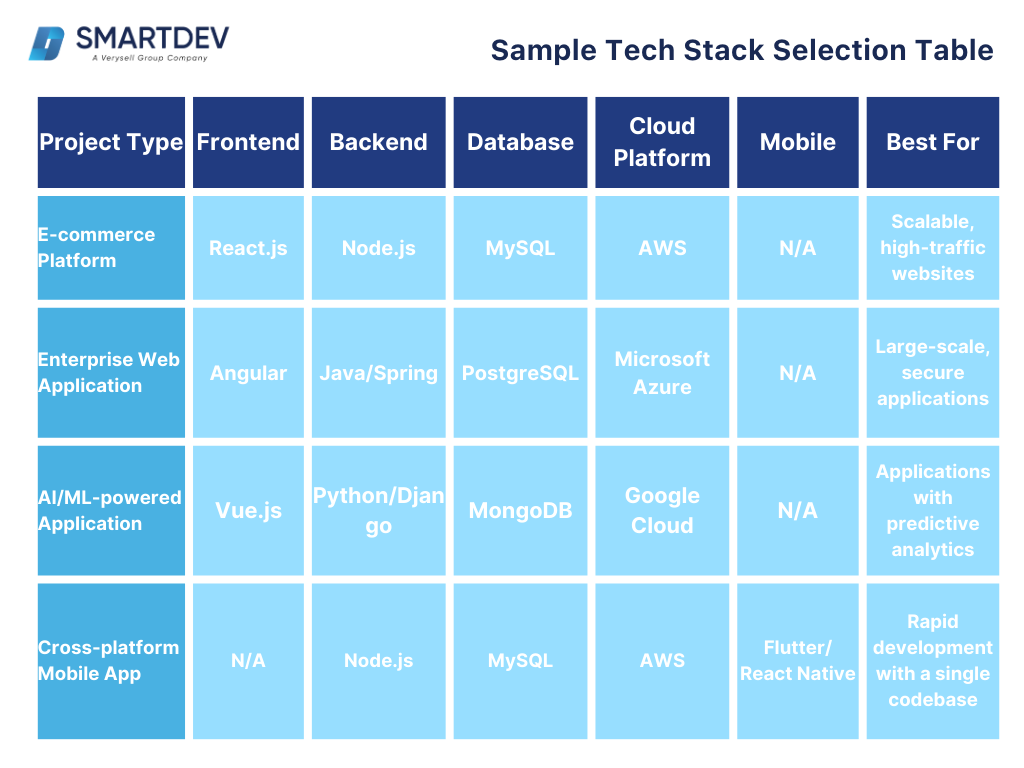
By considering these factors and emerging trends, businesses can confidently select the right technology stack for their Offshore Development project, ensuring optimal performance, scalability, and long-term success.
9. Best Practices for Managing Offshore Software Development
Effective management of offshore software development hinges on maintaining clear communication, setting well-defined objectives, and fostering cultural awareness. Implementing structured workflows, using robust project management tools, and establishing regular check-ins can strengthen alignment, helping distributed teams stay synchronized and focused on project goals.
a. How to Maintain Alignment with Offshore Teams
To ensure alignment between clients and offshore teams, our clients should emphasize clear communication, well-defined objectives, and cultural awareness from the beginning.
For instance, they were advised to establish a structured communication protocol, including regular check-ins, clear channels for feedback, and tools that provide real-time updates. This level of transparency keeps both parties synchronized and maintain focus on project goals.
Another critical factor is precise project scope and requirements. Defining detailed specifications, setting measurable milestones, and aligning on quality standards from the start will prevent scope creep and help manage expectations on both sides. When clients provide a solid roadmap with clear deliverables, OSD teams can work more effectively to achieve the project goals.
Additionally, understanding and respecting cultural and operational differences helps bridge any gaps that might hinder collaboration. Both clients and offshore teams must understand the work culture variations, holidays, and different time zones to build a respectful, cohesive team dynamic.
Lastly, businesses should adopt a robust risk management strategy to anticipate and plan for potential disruptions, establishing contingency or mitigation plans to maintain alignment even when challenges arise. By addressing these areas, clients can foster a productive, aligned relationship with their OSD teams, maximizing the benefits of their offshore partnerships.
b. Agile and Remote Team Collaboration Best Practices
For agile and remote teams to collaborate effectively, specific practices like clear communication, structured workflows, and mutual alignment are essential.
First, we should establish synchronized communication channels to keep all team members updated and aware of project priorities. In this case, using project management tools helps track tasks and timelines, creating visibility and accountability for members.
Next, define roles and responsibilities clearly to prevent duplication and miscommunication. Agile remote teams will surely benefit from well-documented processes and strong coordination so that they can understand their part within the sprint. Additionally, you should also create a shared digital workspace that helps consolidate knowledge, project updates, and important documentation.
Finally, it is important to foster a culture of feedback and flexibility to adapt to changing project needs and ensure continuous improvement.
c. Recommendations
With the right tools and practices, companies can foster efficient workflows and clear alignment across distributed teams.
Below are recommended tools and platforms to enhance communication, support remote team management, ensure milestone tracking, and anticipate risks, creating a streamlined OSD environment.
For more insights into making offshore software development successful, Deloitte’s comprehensive offshoring strategy guide offers in-depth strategies and best practices on planning, managing, and optimizing offshore teams effectively.
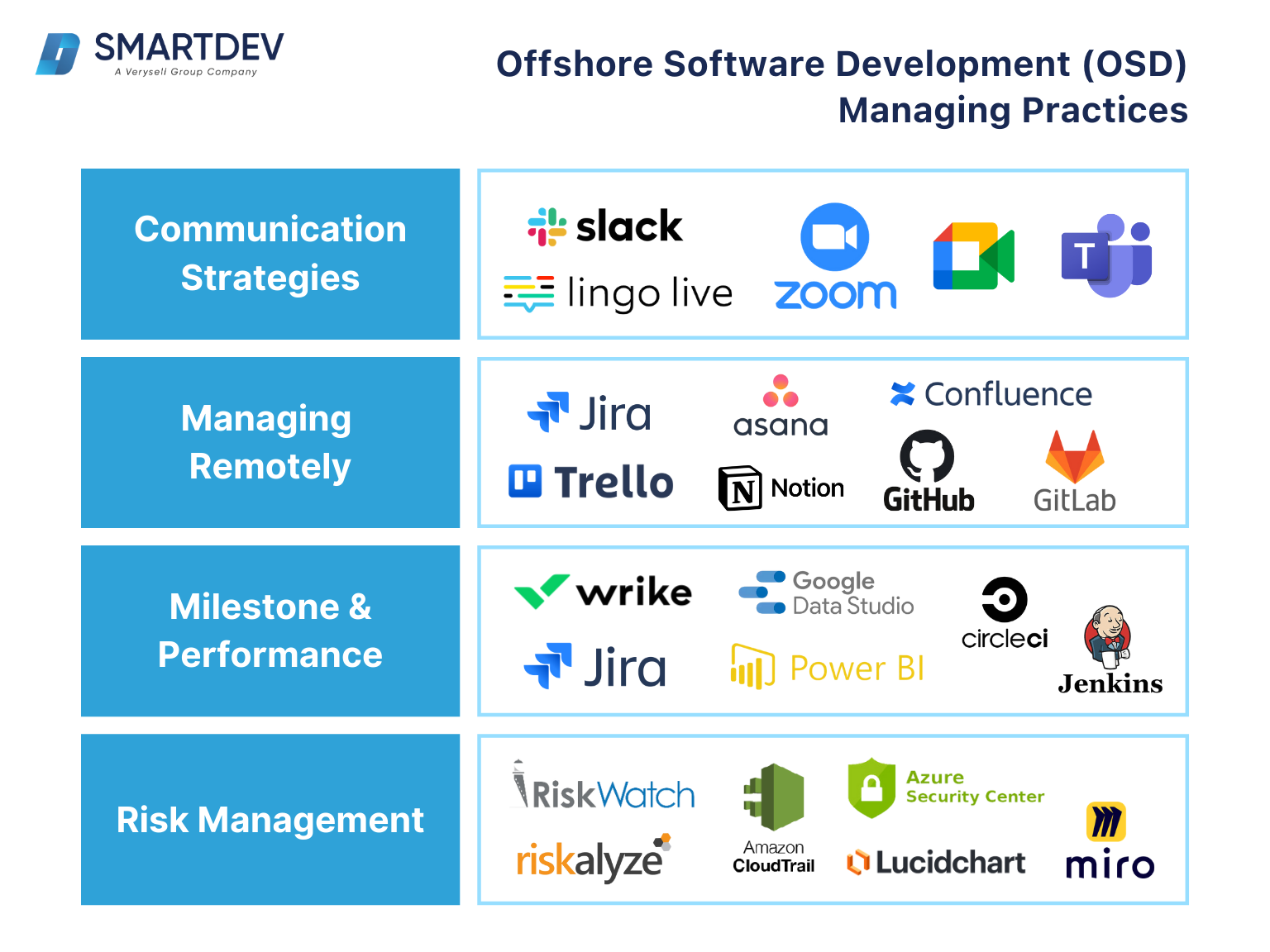
10. Security Considerations in Offshore Software Development
Security is a critical concern in offshore software development, where sensitive data, intellectual property (IP), and business operations must be protected. Organizations outsourcing software development to offshore teams need to address risks related to data breaches, regulatory compliance, and the security practices of their chosen vendor. Implementing robust security protocols can help mitigate these risks and ensure successful, secure collaborations.

a. Protecting Intellectual Property (IP) and Data
One of the primary concerns in offshore software development is the protection of intellectual property (IP) and sensitive data. When working with an external team, particularly in a different country, the risk of unauthorized access, theft, or loss of proprietary information increases. To safeguard IP and data, companies must adopt the following strategies:
- Non-Disclosure Agreements (NDAs): Ensure that all offshore partners sign comprehensive NDAs that clearly outline the responsibilities related to IP protection and data confidentiality.
- Data Encryption: Sensitive data, such as personal customer information or business secrets, should be encrypted both at rest and in transit using industry-standard encryption protocols such as AES-256 and TLS 1.3.
- Access Control: Implement role-based access control (RBAC) to ensure that only authorized personnel have access to critical data and systems. Offshore teams should be granted access on a “need-to-know” basis, minimizing the exposure of sensitive information.
- IP Ownership Clauses: Include explicit IP ownership clauses in contracts that state the client retains full ownership of any code, designs, or processes developed by the offshore team. This ensures that the company has complete control over all intellectual property created during the project.
- Regular Security Audits: Conduct periodic security audits of the offshore team’s practices to ensure they are following security protocols. These audits can be conducted internally or through third-party specialists to verify that data protection measures are being implemented effectively.
b. Ensuring Compliance with Global Regulations
Offshore software development often involves handling data that is subject to global regulations such as the General Data Protection Regulation (GDPR), the Health Insurance Portability and Accountability Act (HIPAA), the Payment Card Industry Data Security Standard (PCI DSS), and other regional compliance frameworks. Failure to comply with these regulations can result in hefty fines and legal consequences. To ensure compliance, companies should take the following steps:
GDPR (Europe):
- For companies handling personal data of European Union citizens, GDPR requires stringent data protection measures, including obtaining consent for data collection, ensuring data portability, and the right to be forgotten.
- Offshore vendors should be familiar with GDPR requirements, and contracts should stipulate compliance obligations to ensure that data processing is in line with GDPR guidelines.
HIPAA (United States):
- Offshore projects involving healthcare data must comply with HIPAA, which mandates secure handling of patient information. Offshore teams working on healthcare software must implement HIPAA-compliant security measures, including encryption, secure authentication, and logging of data access.
Data Residency Laws:
- Some countries have data residency laws that require sensitive data to remain within their borders. Offshore teams should be aware of these restrictions and design systems to ensure that data storage and processing comply with local regulations.
Compliance Certifications:
- Offshore partners should hold certifications such as ISO 27001, which demonstrate their adherence to internationally recognized security standards. These certifications help ensure that the offshore vendor maintains a robust information security management system.
c. How to Audit and Vet Security Protocols
Before partnering with an offshore development team, it is crucial to conduct a thorough audit of their security practices. This helps assess their ability to protect sensitive data and comply with necessary regulations. Companies can follow these steps to audit and vet security protocols:
- Conduct a Security Questionnaire: Request that the offshore vendor fill out a detailed security questionnaire covering key aspects such as encryption, data storage policies, access control measures, and incident response plans. This will provide insights into their existing security infrastructure.
- On-Site Audits: If possible, conduct on-site security audits to evaluate the vendor’s physical and digital security practices. Verify that the team follows best practices in securing development environments, handling sensitive data, and preventing unauthorized access.
- Request Certifications: Ask for evidence of industry-standard security certifications such as ISO 27001, or PCI DSS, depending on the nature of the project. These certifications provide an external verification that the offshore partner follows best security practices.
- Penetration Testing: Engage third-party experts to conduct penetration tests on the systems being developed by the offshore team. Penetration testing simulates real-world cyberattacks to identify vulnerabilities and assess the effectiveness of security defenses.
- Incident Response Planning: Ensure that the offshore vendor has an incident response plan in place, outlining the steps they will take in the event of a security breach. This plan should include provisions for notifying the client, containing the breach, and restoring systems to normal operation.
By following these steps and implementing robust security measures, companies can minimize risks while collaborating with offshore development teams. Security should be a top priority in offshore projects, ensuring the protection of intellectual property, sensitive data, and compliance with global regulations.
11. The Future of Offshore Software Development
Offshore software development is undergoing a significant transformation due to emerging technologies, shifts in the global labor market, and advancements in automation and artificial intelligence (AI). These changes are reshaping how organizations approach offshore outsourcing, from technology choices to vendor relationships. Companies that stay ahead of these trends will be well-positioned to leverage the full potential of offshore software development in the coming years.
a. Impact of Emerging Technologies
Emerging technologies like AI, blockchain, and cloud computing are having a profound impact on offshore software development:
Artificial Intelligence (AI):
- AI is being integrated into various stages of software development to enhance efficiency, accuracy, and innovation. Offshore teams are increasingly using AI for code generation, automated testing, and bug fixing, speeding up the development process while reducing human error.
- AI-powered analytics tools help offshore development teams monitor application performance, identify potential issues early, and optimize systems for better efficiency.
Blockchain:
- Offshore developers are seeing increased demand for blockchain-based applications, particularly in sectors such as finance, supply chain, and healthcare. Blockchain’s decentralized architecture offers enhanced security and transparency, making it highly sought after for building systems that need to be secure, tamper-proof, and trustless.
- Offshore teams specializing in blockchain technologies like Ethereum, Hyperledger, and Solana are working on creating smart contracts, decentralized applications (dApps), and crypto exchanges for global clients.
Cloud Computing and Serverless Architectures:
- Offshore projects are increasingly moving to cloud-native and serverless architectures, which allow for scalable, cost-effective development without the overhead of managing physical infrastructure. Platforms like AWS, Microsoft Azure, and Google Cloud are widely adopted by offshore teams for their flexibility, scalability, and global reach.
- Serverless architectures also support offshore teams by allowing them to focus on writing application logic while cloud providers handle infrastructure, reducing operational complexity.
b. Changing Labor Market Dynamics
The global labor market for offshore software development is evolving rapidly due to factors such as the increased demand for skilled talent, competition between outsourcing destinations, and the rise of hybrid work models.
Talent Shortages and Upskilling:
- As the demand for advanced technical skills such as AI, machine learning, and cybersecurity grows, offshore development firms face talent shortages. Companies are increasingly investing in upskilling their existing workforce to meet these challenges, offering training in emerging technologies.
- Countries that were previously considered low-cost offshore destinations, such as India and the Philippines, are now competing on skill rather than cost alone. Meanwhile, new entrants like Vietnam and Eastern European nations are growing in prominence due to their expanding talent pools.
Remote Work and Hybrid Models:
- The COVID-19 pandemic accelerated the adoption of remote work, which has influenced Offshore Software Development. Many companies now prefer hybrid models, where offshore teams work partially on-site and partially remotely. This flexibility has broadened the talent pool but also requires enhanced collaboration tools and practices to ensure productivity and communication.
c. The Role of Automation and AI in Offshore Services
Automation and AI are playing a central role in redefining the scope and efficiency of offshore software development services:
Automation in Development and Testing:
- Offshore software development firms are increasingly using automation tools for repetitive tasks like code compilation, unit testing, integration testing, and deployment. Automation helps to streamline the development process and reduce the time-to-market, which is crucial for clients with aggressive timelines.
- Tools like Jenkins and CircleCI are widely used for CI/CD (Continuous Integration/Continuous Deployment), while automated testing frameworks like Selenium and Cypress ensure that code quality is maintained even as development cycles become faster.
AI-Driven Development Tools:
- AI-driven tools like GitHub Copilot and Tabnine are assisting offshore developers by suggesting code snippets, identifying potential bugs, and optimizing code efficiency in real-time. These tools significantly reduce the manual effort required in coding and debugging, allowing offshore teams to deliver high-quality products faster.
Robotic Process Automation (RPA):
- RPA is being used in offshore services to handle tasks like data extraction, data entry, and workflow automation. Offshore teams are leveraging RPA tools like UiPath and Automation Anywhere to provide clients with cost-effective solutions for business processes that were previously manual, freeing up developers for more complex work.
d. Trends in Vendor Relationships and Models of Collaboration
Offshore outsourcing is moving from transactional relationships to more collaborative and strategic partnerships:
- Agile Collaboration: Agile methodologies have become standard in offshore projects, with teams working iteratively, ensuring continuous feedback and improvement. This collaborative approach reduces risks and accelerates delivery.
- Outcome-Based Pricing Models: Companies are shifting to outcome-based pricing, where offshore vendors are compensated based on results rather than time spent. This model encourages offshore teams to focus on value creation and business outcomes.
Future Offshore Development Models: A Snapshot
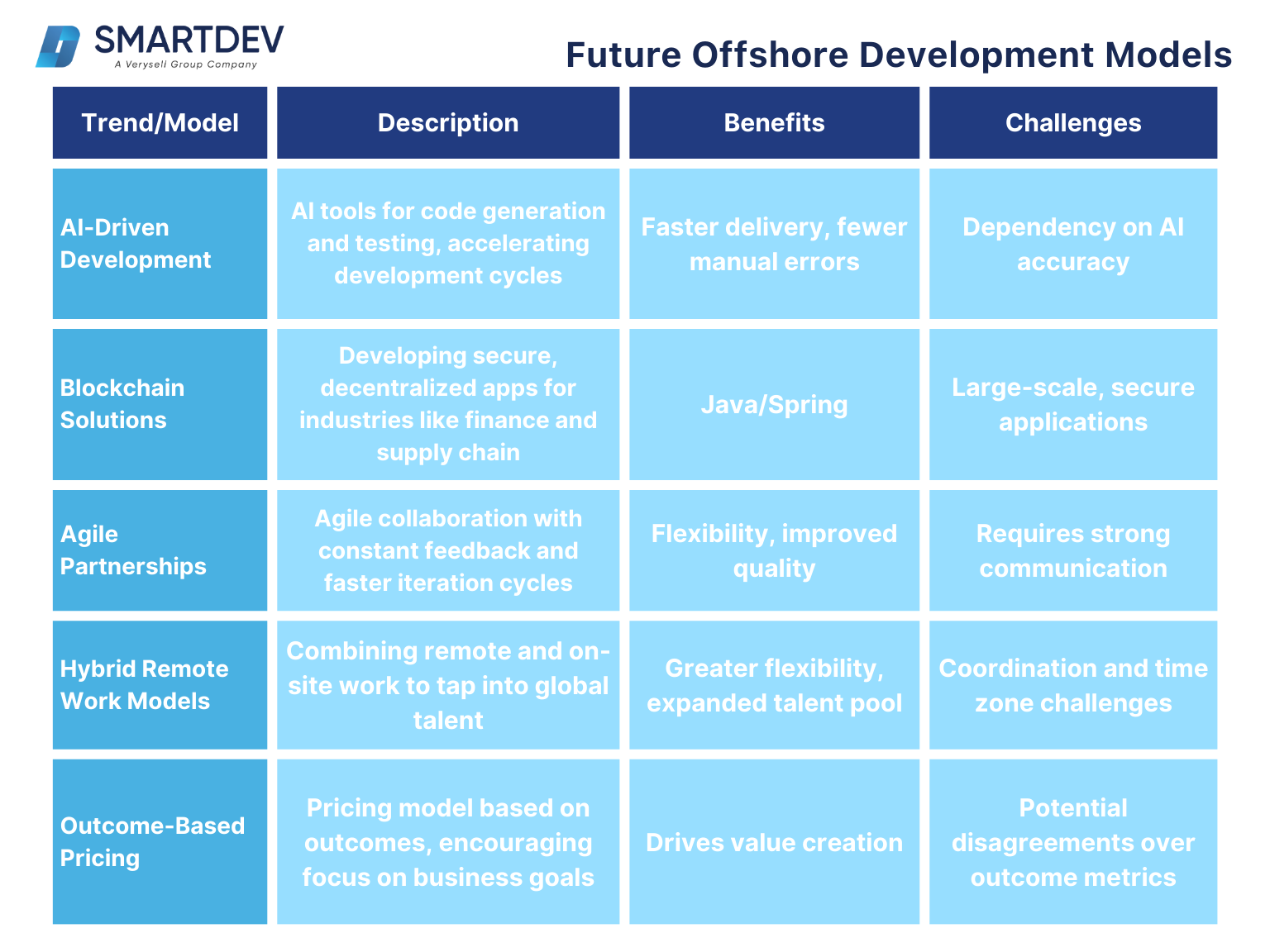
12. Case Studies/Examples
With over 10 years of experience in the IT industry, SmartDev has successfully delivered a numbers of OSD projects since the beginning. SmartDev clients have appeared in multiple industries, which shows the capacity of the company. The project’s success underscores the efficiency, scalability, and technical enhancements achievable through dedicated offshore partnerships, resulting in cost savings and significant operational gains for the clients.
a. Successful Offshore Development Projects in Various Industries
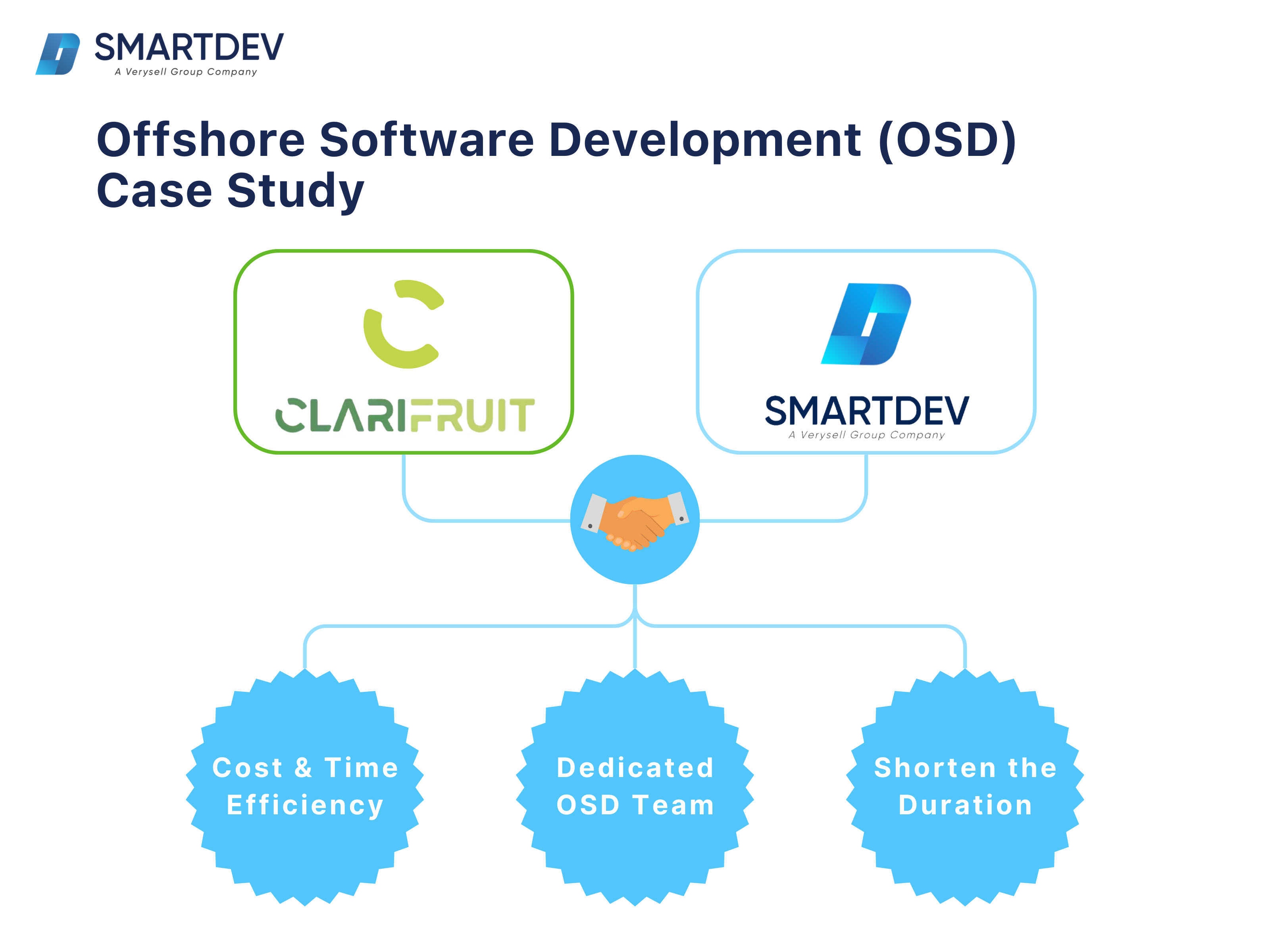
Take SmartDev for an example, we take pride in delivering high-impact Offshore Software Development (OSD) solutions that help our clients excel.
One of our standout projects was the collaboration with Clarifruit, who was a technology company focused on revolutionizing the agricultural in Israel. Their final goal was to change the industry by applying AI-powered quality control solutions to Clarifruit’s clients who required specialized solutions.
However, Clarifruit suffered from difficulties in talent shortage that could have caused significant drawback for them while still had to fulfil diverse needs from the industry. Urging to attract top talent in the tech market to exceed internal capabilities, Clarifruit chose to partner with Smart Dev.
We offered an OSD team to Clarifruit, including 2 developers from Vietnam specifically responsible for each stage from development through testing and deployment. The entire process lasted for around one year from 2023.
The outcomes of Clarifruit’s collaboration were:
- An AI detection system that determines the food quality for users.
- A new mapping that integrates data seamlessly in platforms.
- A modern implementation that helps users to scale across multiple cloud providers.
- A developed interface that supports public APIs for external use.
“That was exactly what we were looking for” – so said by the co-founder of Clarifruit – Ruby Boyarski after our collaboration. This OSD solution exceeded our client expectations and satisfaction.
SmartDev’s collaborative approach and active involvement at every stage of the project guaranteed the successful delivery of innovative and client-centric solutions. From there, Clarifruit was able to combine our strengths to create a scalable solution that’s transforming agricultural quality control.
Key Returns
- Cost & Time Efficiency: SmartDev’s OSD solution allowed Clarifruit to achieve operational efficiency without investing money and time in finding a large in-house team.
- Dedicated OSD Team: Clarifruit gained a powerful tool that reduces manual work, saves time, and enhances accuracy without any disruption.
- Shorten the Duration: Due to working remotely in two different time zones, the working hours for this project were extended, making tasks completed faster and the in-house team was able to focus on developing their core products.
b. How to Avoid Pitfalls
While OSD can deliver substantial benefits, common pitfalls often disrupt its success. Below are some of the most common failures in OSD that we have learned from others and ourselves after years of experiences as an ITO firm.
- Lack of Communication: In a well-known case, IBM’s outsourced project suffered due to time zone conflicts and infrequent updates, causing significant delays. Establishing clear and regular protocols or tools beforehand would improve this.
- Unclear Objectives: For instance, an e-commerce retailer’s vague instructions led to scope creep, misalignment, and over-heading the planned budget. We suggest showcasing the roadmap and requirements with all stakeholders to eliminate those consequences.
- Insufficient Quality Control: A U.S. insurance company’s outsourced claims tool required costly rework due to inadequate early testing. Bugs and usability issues weren’t discovered until late in the process, leading to huge damage. So, in this case, we should have implemented structured quality checks and automated testing tools as well as boost on-going feedback from both sides.
- Cultural Conflict: Another case is a European company’s project with an Indian team faced delays due to differing communication styles. The offshore team’s preference for indirect communication left the client uncertain about their trust. Cultural awareness training is crucial, but you should also schedule a response timeline within working hours.
- Inadequate Risk Management: A fintech startup faced regulatory issues after ignoring security compliance in its offshore-developed app. This pitfall caused a bad reputation for the company. You should also conduct risk assessments early, build contingency plans, and regularly review potential risks with the team.
13. Why Offshore Software Development to SmartDev
When considering partners for Offshore Software Development projects, SmartDev stands out for several reasons:
- Agile Methodologies: At SmartDev, our teams adopt Agile practices to keep your project adaptable and responsive. This ensures efficient delivery while accommodating evolving project requirements.
- Clear Communication: We prioritize transparent and consistent communication. This keeps all stakeholders aligned throughout the entire project lifecycle, leading to seamless execution and on-time delivery.
- Commitment to Security and Quality: We uphold stringent data security measures and robust quality management processes. Our certification in ISO 27001 and following Private Policy Rights like CCPA, GDPR Data Protection or Third-Party Privacies demonstrating our dedication to safeguarding your data and delivering high-quality outcomes.
- Flexible Engagement Models: We offer various offshore development options, including staff augmentation, dedicated teams, and project-based contracts. These flexible models are tailored to meet the specific needs, budget, and timelines of your project, ensuring optimal results.
- Access to Top Talent: With office in Vietnam (Danang, Hanoi) and overseas (Singapore, UK, Switzerland, US, Dubai, Uganda), SmartDev is the place where top talents meet in IT industry. Our skilled experts are adept at handling complex project demands, ensuring you receive the best technical solutions.
14. How to Start Your Offshore Software Development Journey
Starting an offshore software development journey requires thoughtful planning, clear expectations, and a structured approach. This process involves selecting a capable offshore team, budgeting, and creating a seamless transition from in-house to offshore operations.
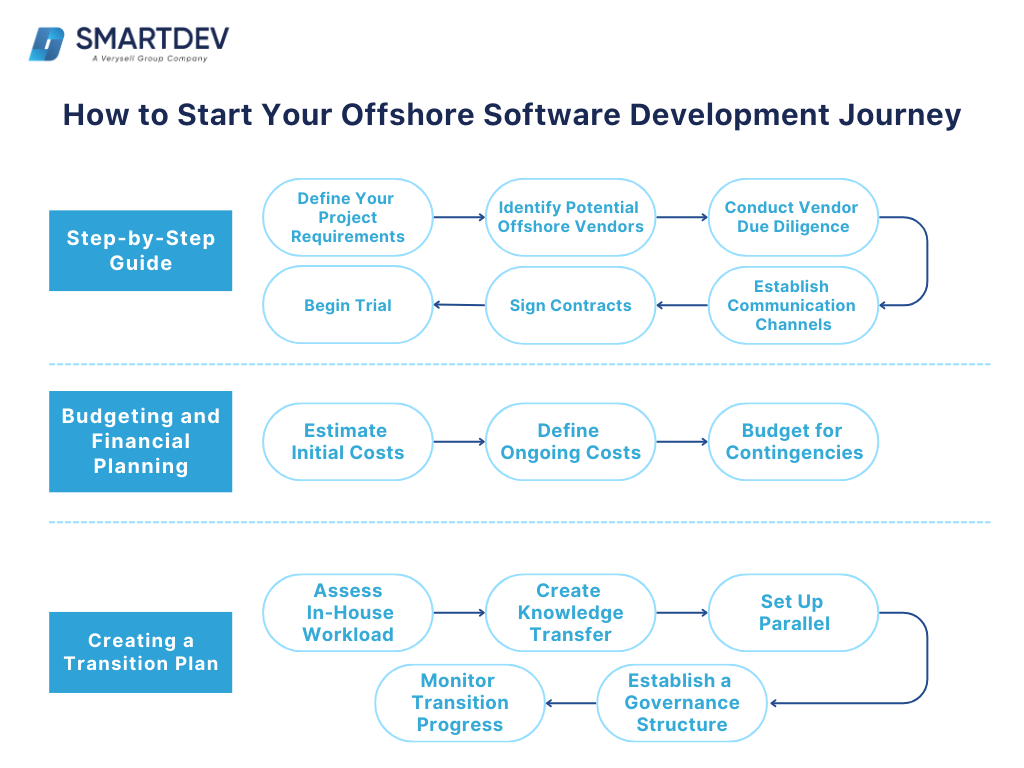
a. Step-by-Step Guide to Onboarding Your First Offshore Team
Successful offshore software development begins with choosing the right partner and setting up a clear onboarding process. Here are key steps to ensure a smooth start:
Step 1: Define Your Project Requirements:
- Outline project goals, technical requirements, timelines, and expected deliverables.
- Decide on the technologies, tools, and development methodologies (e.g., Agile or Scrum) that will guide the project.
Step 2: Identify Potential Offshore Vendors:
- Research vendors based on their expertise, geographical location, and industry reputation.
- Assess factors like communication practices, time zone alignment, and security protocols.
Step 3: Conduct Vendor Due Diligence:
- Review vendor portfolios, request client references, and conduct interviews with their team leads.
- Request any relevant certifications (e.g., ISO 27001) to ensure compliance with security standards.
Step 4: Establish Communication Channels and Collaboration Tools:
- Choose communication platforms like Slack or Microsoft Teams and project management tools such as Jira or Trello to streamline interactions.
- Schedule regular check-ins to monitor progress, address questions, and maintain alignment with project goals.
Step 5: Sign Contracts and Define KPIs:
- Draft a contract that includes clear deliverables, timelines, confidentiality agreements, and intellectual property clauses.
- Establish KPIs to monitor progress and ensure accountability, such as milestones for code quality, speed of delivery, and adherence to deadlines.
Step 6: Begin a Trial Period:
- Start with a pilot project to assess the offshore team’s capabilities and work quality before committing to larger projects.
- Gather feedback, review the project outcomes, and determine if the partnership is suitable for long-term collaboration.
b. Budgeting and Financial Planning for Offshore Development
Careful budgeting is critical to achieving ROI in offshore projects. The financial planning process should account for various cost factors beyond developer salaries, including infrastructure, communication, and quality assurance.
Estimate Initial Costs:
- Vendor Selection and Due Diligence: Budget for any expenses related to vendor screening and travel (if on-site visits are required).
- Legal and Contractual Fees: Include costs for drafting contracts, IP protection clauses, and compliance agreements.
- Setup Costs: Account for tools and infrastructure setup, including any licenses for software tools used by the offshore team.
Define Ongoing Costs:
- Developer Salaries and Benefits: Factor in offshore market rates for developers, project managers, and QA personnel.
- Project Management and Oversight: Budget for an in-house manager to oversee the offshore team and ensure alignment with business objectives.
- Communication and Coordination: Include expenses for collaboration tools and any travel costs for in-person meetings, if necessary.
Budget for Contingencies:
- Quality Control and Rework Costs: Set aside funds to cover potential rework or additional quality assurance measures.
- Security and Compliance: Allocate resources for regular security audits, especially if handling sensitive data subject to regulations like GDPR or HIPAA.
- Currency Fluctuations and Legal Fees: Consider currency exchange risks and any legal fees associated with cross-border agreements.
c. Creating a Transition Plan from In-House to Offshore
Transitioning development activities from an in-house team to an offshore team involves careful planning to minimize disruptions and ensure seamless continuity. A clear transition plan can help manage expectations, maintain productivity, and set the offshore team up for success.
Assess In-House Workload and Transfer Scope:
- Identify which tasks or projects can be transferred to the offshore team and what should remain in-house.
- Prioritize non-core tasks or specific projects that align with the offshore team’s expertise, allowing in-house teams to focus on strategic initiatives.
Create Knowledge Transfer Documentation:
- Develop comprehensive documentation detailing the project’s history, codebase, workflows, and any domain-specific knowledge.
- Record key contacts, critical project dependencies, and known issues to help the offshore team quickly understand the project context.
Set Up Parallel Operations:
- Run a parallel operation where both the in-house and offshore teams work together initially, ensuring a smooth handoff.
- Gradually transition full ownership of tasks to the offshore team while monitoring their performance and quality.
Establish a Governance Structure:
- Define roles, responsibilities, and escalation paths to ensure accountability across teams.
- Assign an in-house liaison to facilitate communication, provide guidance, and address questions or concerns from the offshore team.
Monitor Transition Progress and Provide Feedback:
- Regularly review project milestones and assess the offshore team’s integration progress.
- Provide constructive feedback and make adjustments as needed, ensuring that the offshore team aligns with company culture and project expectations.
Sample Transition Timeline
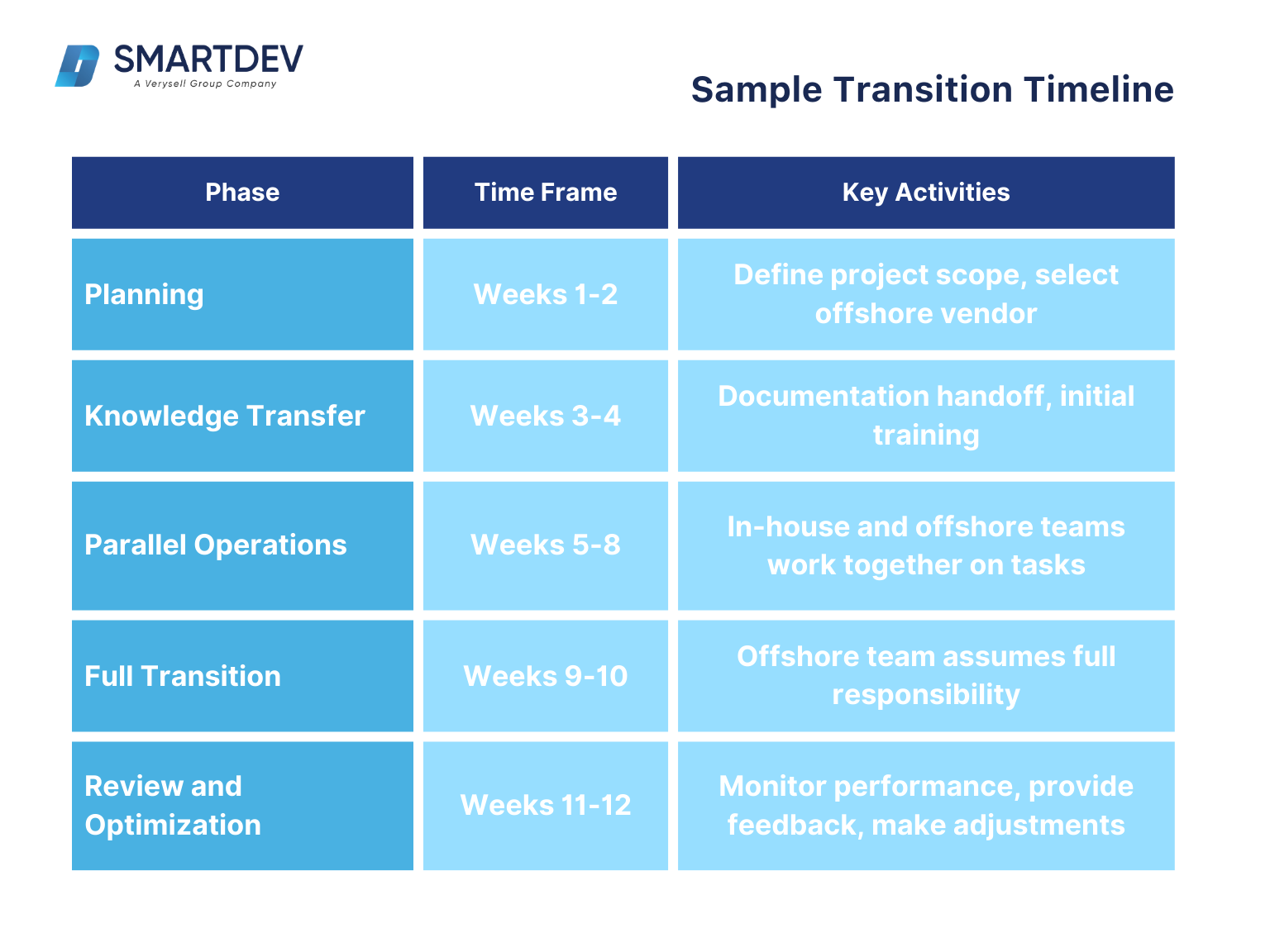
Frequently Asked Questions
What are the main benefits of Offshore Software Development?
Offshore Software Development offers access to a wider pool of skilled talent, often at a more competitive cost. It enables companies to scale development resources flexibly, work across different time zones for faster project turnarounds, and benefit from specialized expertise without having to invest heavily in local hiring.
How does SmartDev ensure data security and IP protection?
SmartDev prioritizes data security and IP protection by implementing comprehensive contracts that clearly define IP ownership rights, particularly for custom software solutions. Additionally, SmartDev complies with international data protection regulations, like GDPR and ISO27001, and incorporates secure communication channels and robust data management practices to prevent unauthorized access or data breaches.
How is project quality ensured when working with an offshore team?
To maintain project quality, SmartDev sets clear project requirements and KPIs, establishing quality benchmarks from the start. Regular communication and feedback loops allow for continuous alignment on project goals. Quality is monitored through structured testing, bug tracking, and feedback to ensure the final deliverables meet client expectations.
Common Myths about Offshore Software Development
“Is offshore development limited to certain types of technology or industries?”
No, offshore development is versatile and can support a wide range of technologies and industries. At SmartDev, we have expertise in popular tech stacks, including AWS, Magento, and Shopify, enabling us to support clients across e-commerce, finance, healthcare, and other sectors with specialized solutions that meet industry standards.
What to Expect During the Initial Phases
“What are the typical steps taken in the onboarding process with an offshore team?”
During onboarding, SmartDev follows structured steps to ensure a smooth start. This process includes a thorough requirements gathering phase, defining project scope, aligning on KPIs, and identifying the team members involved on both the client and offshore sides. Regular initial meetings are held to clarify expectations, and collaboration tools are set up to facilitate ongoing communication and project tracking.
Answers to Typical Concerns from Business Leaders
“How does SmartDev ensure alignment with our business goals and KPIs?”
SmartDev aligns closely with client goals by establishing KPIs that measure project success and meet specific business objectives. Regular check-ins, progress reports, and open feedback loops keep both teams in sync. This proactive approach allows SmartDev to adapt to any changes in scope or priorities, ensuring the final product aligns with the client’s strategic goals.
Summary
1. Introduction to Offshore Software Development
- Definition: Offshore Software Development (OSD) is outsourcing software tasks to teams abroad, merging cost savings with specialized expertise.
- OSD has become essential in tech, building global talent hubs and aiding both startups and large corporations with agility and innovation.
- OSD is ideal for startups needing affordable talent, companies seeking scalability, and established firms requiring niche skills and faster market entry.
2. Types of Outsourcing in Software Development
- Outsourcing Types: Onshore, nearshore, and offshore models vary by cost, communication ease, and talent access, chosen based on geographic needs.
- Development Methodologies: Waterfall, Agile, and Hybrid models offer structured, flexible, or mixed methodologies depending on project requirements.
3. Cost of Offshore Software Development
- Significant Cost Savings: Offshore development can reduce costs by 50%-70% compared to onshore, with lower hourly rates in regions like Eastern Europe, South Asia, and Latin America.
- Key Cost Components: Major expenses include developer salaries, management fees, and technology stack choices, with costs varying by tools and platforms used.
- Hidden Costs: Potential extra expenses like communication challenges, time zone delays, and quality rework may increase total costs by up to 20%.
- Best for Budget Optimization: Offshore development is especially beneficial for companies aiming to cut IT expenses without sacrificing project quality.
4. Key Benefits of Offshore Software Development
- Cost Savings: OSD reduces expenses by tapping into regions with lower labor costs, minimizing recruitment, training, and operational expenses.
- Global Talent Access: It provides access to specialized skills worldwide, enhancing innovation and expertise beyond local markets.
- Scalability and Flexibility: OSD allows companies to adjust resources based on demand, easily scaling up or down without permanent commitments.
5. Common Challenges in Offshore Software Development
- Communication and Time Zones.
- Quality and Compliance.
6. How to Choose an Offshore Development Partner?
- Key Evaluation Criteria: When selecting an offshore vendor, focus on their technical expertise, portfolio of similar projects, communication practices, cost-quality balance, and ability to scale with your project needs.
- Alignment of Goals: Ensure clear goals by providing detailed requirements, setting regular check-ins, defining KPIs, and maintaining an open feedback loop.
- Legal Protection: Establish a solid contract covering scope, IP ownership, data security, and dispute resolution to protect your interests.
- Best Practices: Start with a pilot project, perform reference checks, interview team members, and, if possible, conduct site visits or review third-party feedback for comprehensive vendor assessment.
7. Offshore Development Team Structures
- Team Models (Dedicated vs. Project-Based): A dedicated team works long-term as an extension of the client’s in-house team, ideal for evolving projects needing flexibility. Project-based teams, however, focus on a single project with clear objectives and timelines, perfect for fixed-scope work.
- Key roles include project managers, technical leads, developers, quality assurance engineers, and business analysts, each ensuring efficient, quality delivery.
8. Technology Stack Selection in Offshore Development
- Popular Technologies: Offshore projects commonly use technologies like React, Angular, Node.js, Python/Django, and cloud platforms like AWS for scalability, with each tech stack suited to specific project types (e.g., cross-platform mobile apps, e-commerce platforms).
- Emerging Trends: Offshore development is integrating new trends, including AI/ML for automation, blockchain for security, serverless architecture to simplify infrastructure, and CI/CD for faster, collaborative development cycles.
- Choosing the Right Stack: Key factors include project requirements, scalability, team expertise, and cost efficiency; for instance, select React Native or Flutter for quick mobile development or Java/Spring for secure, enterprise-grade applications.
- Tech Stack Selection: Aligning the tech stack with project needs ensures performance and efficiency, whether it’s for a high-traffic e-commerce site, a real-time application, or a secure financial platform.
9. Best Practices for Managing Offshore Software Development
- Maintaining Alignment: Clear communication, defined objectives, and cultural awareness are essential to synchronizing client and offshore team efforts.
- Recommended platforms and tools were introduced to clients and offshore teams in terms of four main requirements (communication, milestone & performance, quality, and risk) to ensure effective project management.
10. Security Considerations in Offshore Software Development
- IP and Data Protection: Implement measures like NDAs, data encryption, access control, IP ownership clauses, and regular security audits to safeguard intellectual property and sensitive data when collaborating with offshore teams.
- Compliance with Global Regulations: Ensure offshore vendors adhere to regulatory standards like GDPR, HIPAA, and local data residency laws, and verify compliance certifications (e.g., ISO 27001) for secure handling of regulated data.
- Vetting Security Protocols: Conduct thorough security audits, including security questionnaires, on-site inspections, certifications checks, and penetration testing, along with ensuring vendors have a well-defined incident response plan.
11. The Future of Offshore Software Development
- Emerging Technologies and Their Impact: AI, blockchain, and cloud computing are transforming offshore development. AI enhances efficiency through automated coding and testing, blockchain is growing in demand for secure applications, and cloud/serverless architectures simplify scalability and reduce costs.
- Shifts in Labor Market and Work Models: Offshore development faces talent shortages and is adapting with upskilling, hybrid work models, and growing competition from emerging markets like Vietnam and Eastern Europe.
- Automation, AI, and Evolving Vendor Relationships: Automation tools streamline tasks and reduce time-to-market, while new collaboration models emphasize agile methodologies, outcome-based pricing, and strategic partnerships.
13. Why Offshore Software Development to SmartDev?
- Agile and Transparent Practices: SmartDev utilizes Agile methodologies and clear communication to ensure project adaptability, seamless execution, and on-time delivery.
- Security and Quality Assurance: Certified in ISO 27001 and compliant with policies like GDPR and CCPA, SmartDev prioritizes stringent data security and high-quality outcomes.
- Flexible Engagement and Global Talent Access: Offering various engagement models, SmartDev alters solutions to project needs and connects clients with skilled IT talent across multiple global offices.
14. How to Start Your Offshore Software Development Journey?
- Structured Onboarding Process: Successful offshore software development begins with clearly defining project requirements, selecting the right vendor, and establishing effective communication channels and collaboration tools to ensure alignment throughout the project lifecycle.
- Budgeting and Financial Planning: Careful budgeting is essential, considering initial costs (vendor selection, legal fees, and setup costs) and ongoing expenses (salaries, project management, and communication tools), along with contingency planning for quality control and compliance.
- Seamless Transition from In-House to Offshore: Creating a transition plan involves assessing the in-house workload, developing knowledge transfer documentation, running parallel operations, and establishing a governance structure to monitor progress and provide feedback, ensuring a smooth handoff to the offshore team.








